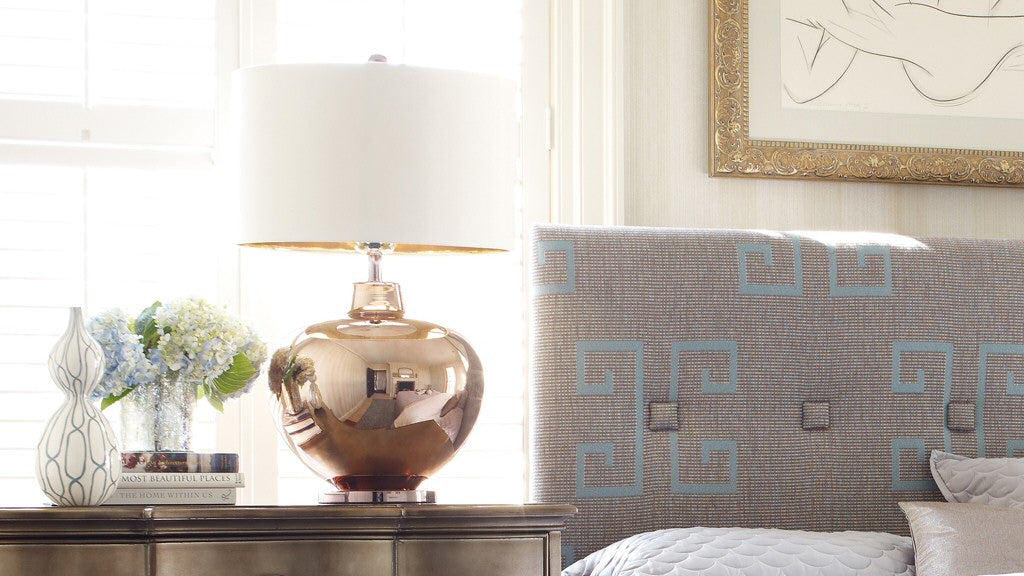
Lamps: How to Choose Floor Lamps, Table Lamps and Lamp Shades
Search
Learn all about Bedroom Lamps and Living Room Lamps
What is a lamp?
A lamp is a form of electrical lighting where the light source is portable and can be plugged into a standard electrical outlet. A portable lamp features:
- One or more light bulbs or another source of light, such as LED bulbs
- A lamp shade to prevent glare from the bulbs and to aim or diffuse the light for practical purposes
- A lamp base which raises the light source higher up and supports the light bulb and lamp shade
- A power cord to plug the lamp into a nearby electrical socket
- A switch to turn the lamp on and off or adjust the brightness level
- Decorative elements designed to make the lamp attractive and coordinate with your room theme
Bedroom lamps

Lamps are very popular for bedrooms due to their wide range of styles, portability and practical benefits. Bedside lamps may sit on your nightstand or on a small bedside table. Alternatively they can be positioned in corners of the bedroom.
Using lamps in the bedroom helps to create an intimate space because they draw attention to smaller areas of the room where people are active or relaxing, rather than flooding the whole bedroom with bright light.

Bedside table lamps are particularly popular due to their proximity to the bed, allowing you to easily switch them on and off without having to leave the comfort of the bed. Nightstand lamps for bedrooms set the mood and are within arm's reach in the middle of the night.
If you want bedside lamps or a reading light for bed, another great option is a bedroom floor lamp or reading lamp, which can arc over the bed and provide light more directly from above.
A further choice for a bedroom lamp is to place a tall standing floor lamp in the corner of the room. Floor lamps offer brighter light than table lamps for when you need to give the bedroom a boost. They also tend to provide more ambient light to light the whole room.
As a finishing touch, add a small accent lamp to the bedroom to act as a soft night light or to create a playful or romantic mood.
Living room lamps
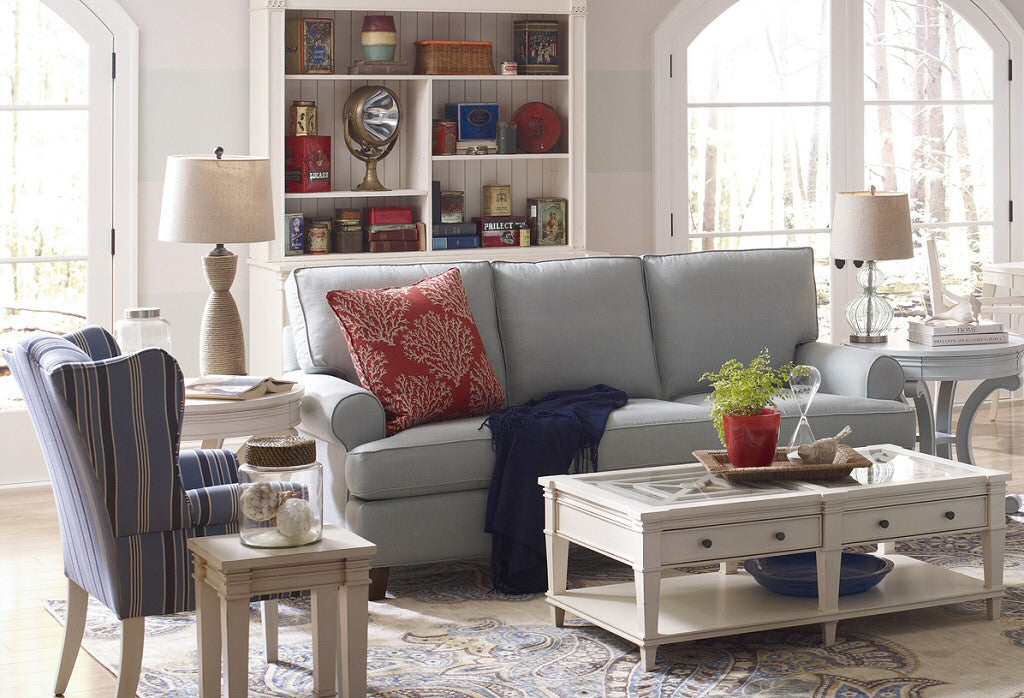
Lamps for living rooms include floor lamps, reading lamps, table lamps and accent lamps. Living room lamps tend to focus on brighter light since you'll sometimes be spending more time in the living room and may need to see more clearly.
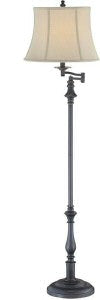
Table lamps for living rooms and family rooms have been a popular choice for many years. Position a pair either side of a couch or in two corners of a room to create balance. End table lamps can stand on a chair-side or end table positioned next to your favorite seating area. When seated, the table lamp will be next to you and will share its light outward from below, lighting your lap.
Living room floor lamps are also a great way to add strong light to a living room. The floor lamp is typically designed to send light upwards which reflects off the ceiling as ambient light, and these tall standing lamps tend to have brighter light bulbs than table lamps. They may also feature adjustable brightness levels, LED, dimmable bulbs or a reading-arm which extends from the side over a chair.
If you have a small desk in your living room, a helpful addition is a desk lamp. Place desk lamps on top of the desk or to the side. These versatile adjustable lamps allow you to light the desk surface without the lamp itself being in the way. The lamp head can usually be easily moved to aim the light where you need it.
As finishing touches, add some accent lamps near to people or at the edges of the room to provide decorative low-level lighting or to double as a night light.
Lamps for other rooms of the home

Bathroom Lamps
With not a lot of room to move, floor lamps and table lamps might not be a good choice for a bathroom. However, counter-space will probably allow for a small accent lamp. The purpose of the lamp is mostly decorative but it can also make for a great low-level night light.
Dining room lamps
Stylish floor lamps are a great addition to a dining room. They can stand in a corner out of the way of traffic and provide a strong level of light for the room. If your dining room has enough space, one or two accent lamps on a side table can set the mood.
Hallway lamps
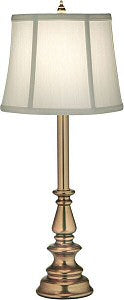
Hallways tend to be narrow with little room for extra lamps. However if you have a hallway table or narrow buffet table against a wall, it's the perfect location for a buffet lamp. Buffet lamps are taller, narrower table lamps designed to stand on narrow furniture. Accent lamps are also another option for limited spaces.
Home office lamps
Anything goes in the home office but in particular look for some full-spectrum lamps such as a full spectrum floor lamp or desk lamp. Designed to reduce glare and represent colors more accurately, this can only be helpful for your eyesight when you're sitting focusing for extended periods of time, reading paperwork or embarking on creative activities.
The shape of light output
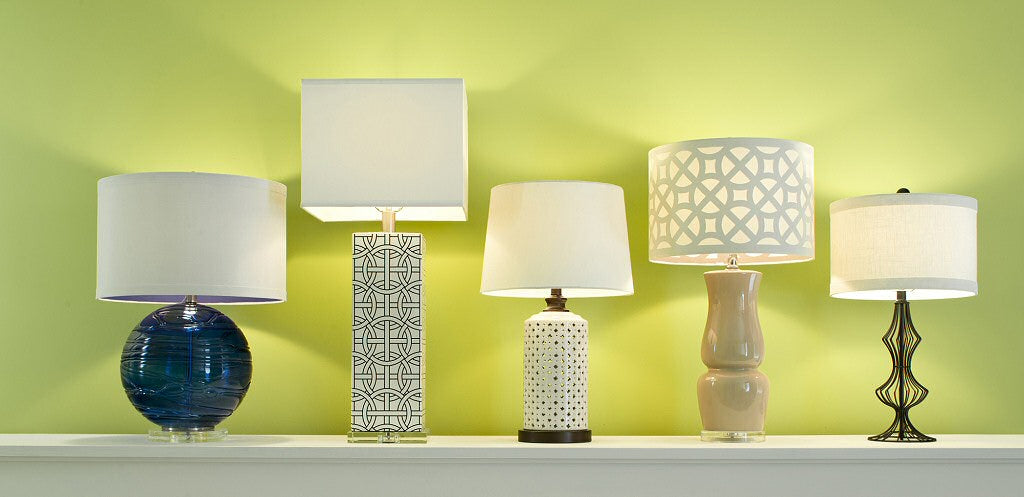
Lamps produce light in two main stages:
- Position the light source in the room and at a certain height
- Deflect and aim the light using a shade designed for a certain purpose
It's important to realize that the shape of the lamp shade, i.e. the shade covering or surrounding the light bulb, has a dramatic influence over which directions the light will shine from the lamp.
How "solid" the lamp shade is also influences whether it will reflect all of its light out the ends of the lampshade, or whether some light will pass through and illuminate the shade itself. Hard-backed or lined shades will block light from passing through the shade, and will focus more light out the top and bottom of the lampshade.
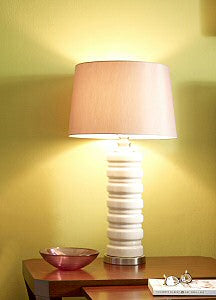
The shape of the lamp shade will determine the shape of the "cone" of light which emits from the lamp. A lampshade with vertical sides such as a drum lamp shade, will equally emit light from the top and bottom, with much of the light spreading outwards to cover a wide area.
A lampshade with a smaller opening at the top than the bottom, for example with an empire shade or bell shade, will shine more light out from the bottom and spread the light over a wider area. Table lamps tend to have lampshades which are wider at the bottom, compared to floor lamps, because they will be positioned lower and need to spread the light out further, whereas a floor lamp shines more from above.
Some lamps such as desk lamps or accent lamps may shine light in all directions. Also lamps with transparent or partly transparent/fabric lamp shades will emit some light through the sides of the lamp and this will also tint the light by the color of the lampshade. For example a red lampshade may emit a warm glow. A whiter lamp shade will emit white light. Lamp shades are also changeable, so if you're not happy with a lamp's shade, just swap it out!
Where to place portable lamps
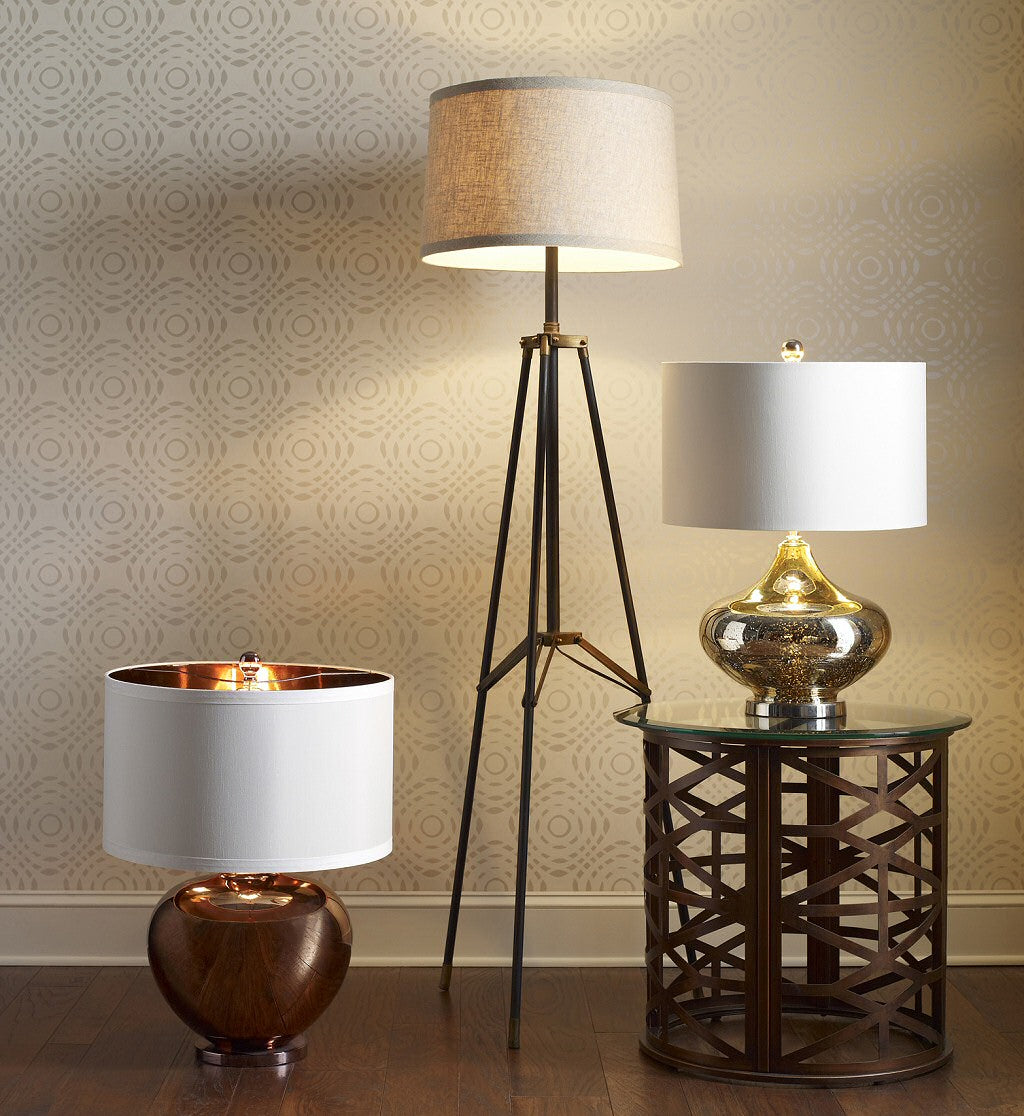
Lamps are portable and can be easily moved to different rooms or to a different location in the same room. This means you can tweak them to suite your room layout, and when you're ready for a fresh experience you can relocate them.
The ideal position of a lamp depends partly on the height of the lamp and the shape of the lamp's shade. A tall floor lamp or standing lamp such as a torchiere may be best located either behind a seating area or in a corner of the room away from seating. Since the light source is higher in the room, you may see the glaring light bulb if you place it too near in front of a chair.

Positioning a floor lamp behind or to the side of a chair is also ideal since it shines most of its light downwards. A possible exception is a floor reading lamp which is designed specifically for reading while seated and are not as tall as regular floor lamps, so can be positioned to the side of or behind your chair.
Table lamps are best placed next to a chair or sofa, or in the corners of a room. Their flared shades tend to spread light outward and can be best used next to a seating area. Their shorter stature requires them to be positioned on top of furniture and are designed to shield your eyes best when seated.
Desk lamps will be located on a desk surface and ideally toward the rear of the desk or above the desk. They are usually short and can be adjusted so that the light bulb is not shining into your eyes directly, aiming most of its light onto the work surface.
Accent lamps are best placed either at the edges of the room such as on a shelf or side table, or as a small highlight near to where people will be relaxing.
How to match the lamp style to your room theme

Lamps are available in a very wide variety of styles ranging from vintage to ultra-modern. Decide what the theme of your room is and try to match the lamp style to your home decor.
Lamps with very clean lines, bold shapes, bright colors and an absence of small details tend to be seen as modern lamps. Minimalist materials and striking geometric shapes enhance the modern look.
Lamps with more decorative, ornate fine details, scrollwork, fancy curves and old-school materials such as bronze, brass and wood tend to come across as classic, vintage, antique or traditional-styled lamps.
You can also choose whether to let the lamps sit in the background with minimal style or whether they will make a statement and add to the room. A colorful shade or lamp base can add a pop of color, or the lamp can simply serve a function and focus on clean white, subdued or transparent materials.
Try to pick up some main or accent colors from your room's color scheme to use the lamps as a finishing touch in your interior design.
How much light does a lamp produce
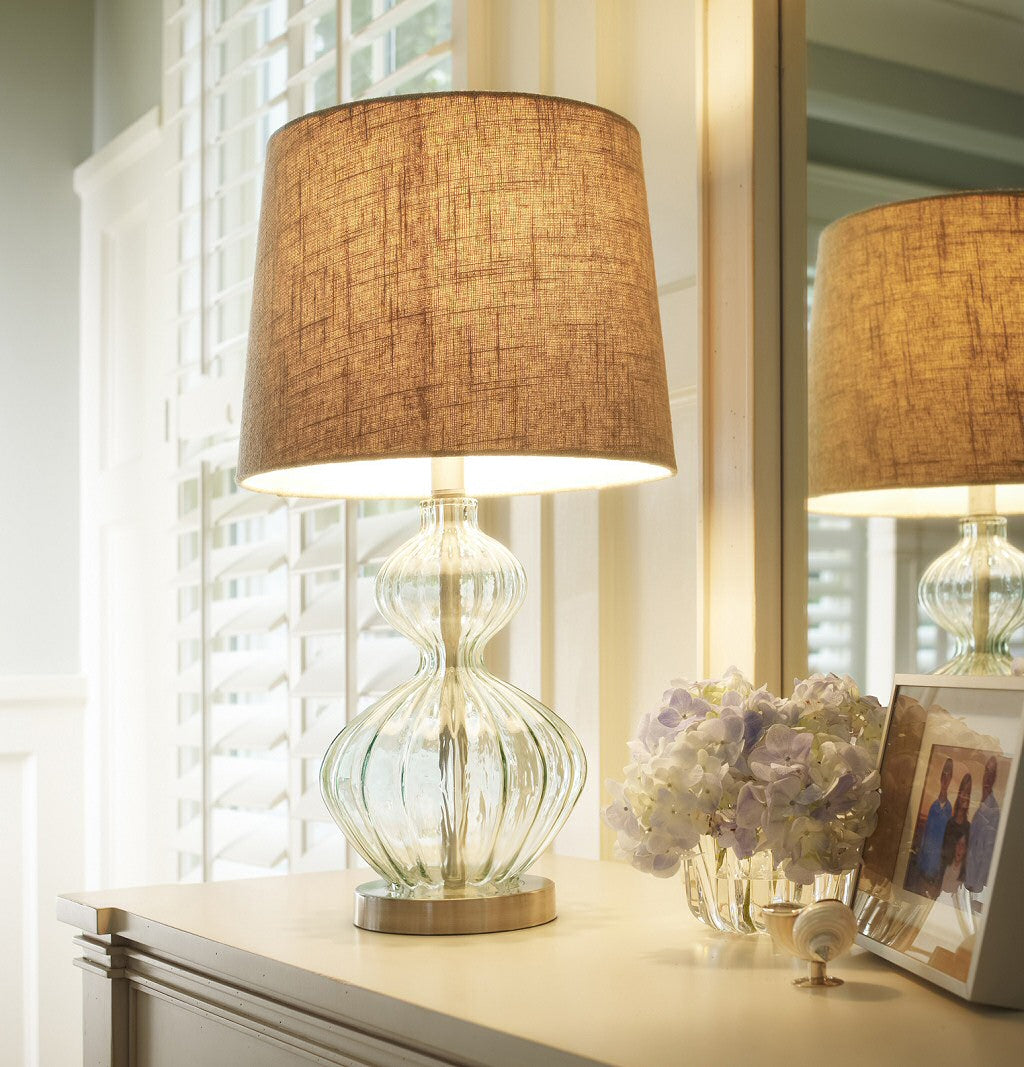
The amount of light output from a lamp depends mostly on the light bulb intensity, how much light is filtered through the shade, and also the position of the lamp and its distance from objects.
A bright lamp placed twice the distance from an object may not light the object any brighter than a less-bright lamp placed nearby. Light spreads out and appears to grow dimmer as it moves further from the light source. With this in mind, light important areas such as your favorite chair with a nearby lamp, and use lamps further away to produce ambient light.
Floor lamps are generally the brightest type of lamp, often in the 300-Watt+ range and featuring upwards of 3 light bulbs or equivalent. This is generally double the output of a table lamp.
Reading lamps generally will produce the next brightest light since they are a form of a floor lamp with a concentrated light positioned close to where you are reading.

Table lamps usually output in the region of 100 to 150 watts of incandescent light. Some may feature a 3-Way bulb which allows you to adjust the light level. Occasionally a table lamp may feature 2 bulbs which provides an opportunity for brighter light, but must use one bulb.
Desk lamps may create a similar amount of light to table lamps but in a more focused area over a desk, and so may appear brighter overall.
Accent lamps are the dimmest of all lamps often using only 7-watt bulbs or similar. They can increase the mood in the room or add a night-light option, but are not bright enough to adequately light a whole room or for performing tasks.
Tip to brighten a lamp: One way to increase the amount of light in your lamp, within safety limits, is if you switch out an incandescent bulb and use either a fluorescent or LED bulb. Since these modern bulbs use much less wattage to produce the same amount of light, you can actually put a higher-equivalence/wattage bulb into the lamp and it will produce even more light than a regular bulb while still being within the wattage rating of the lamp. Just be sure never to use any type of bulb with a wattage higher than your lamp's maximum wattage rating.
How adjustable is the lamp
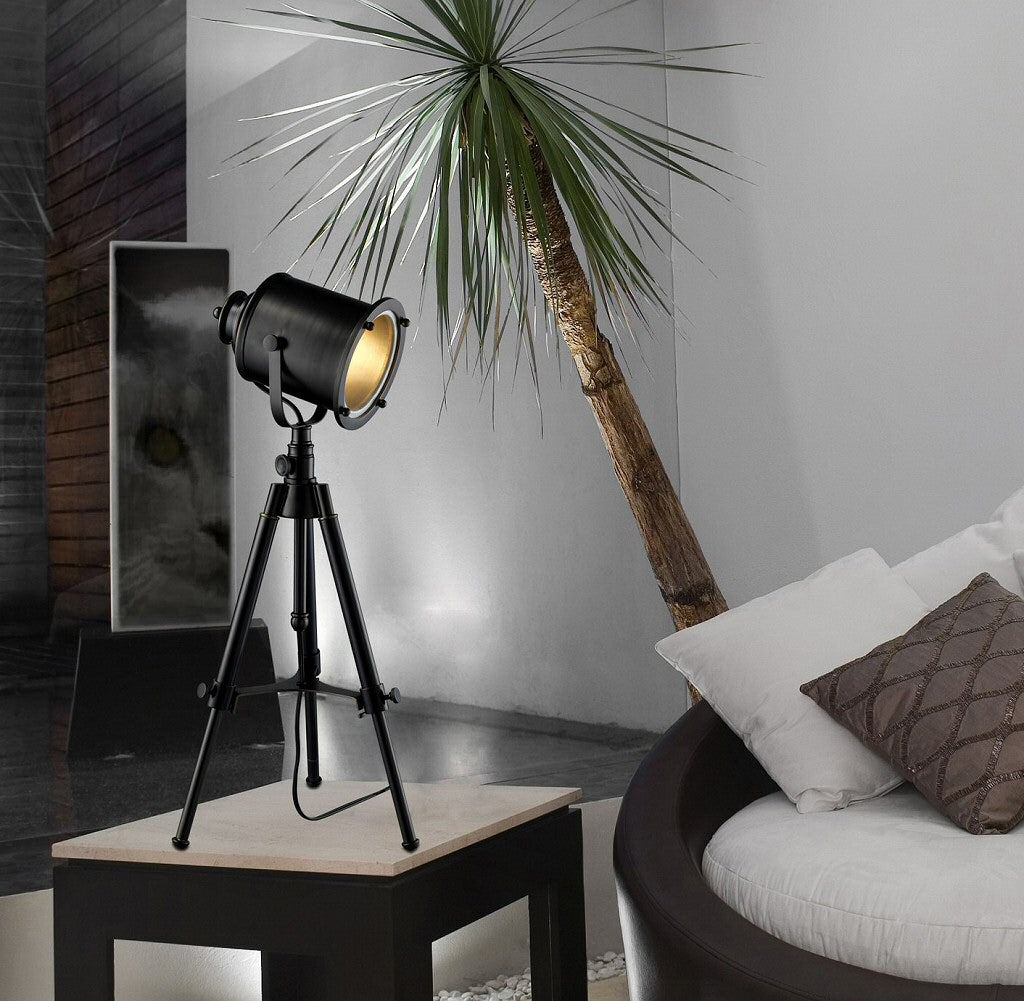
Some lamps are more adjustable than others. Floor lamps tend to be the least adjustable. In particular torchieres may not be adjustable at all, other than the brightness level. Light may not be aimable and so the lamp position is important.
Lamps with a lamp shade can sometimes be tilted to aim the shade a little more to one side. But similar to floor lamps they tend not to be very adjustable and are mostly designed to sit in one position.
Desk lamps in particular are very adjustable as a gooseneck lamp or via a set of hinged joints which allow the lamp head to be moved around and aimed easily in multiple directions. Reading floor lamps also are likely to be more adjustable than other types of lamps, since you may need to particularly aim the light for the most comfortable reading experience.
Some types of lamps, for example pharmacy floor lamps, may be designed to be more adjusted than others, such as raising of lowering the height of the lamp, positioning the lamp head on a swing-arm, or allowing the lamp head to be tilted.
If you need to be able to move and adjust your lamp for a practical reason, make sure to choose a lamp designed for the purpose.
Types of floor lamps

Floor lamps are available in several designs designed for different functions. Consider what you want your floor lamp to do and what kind of light or direction of light you want it to provide.
Tall standing lamps
Traditional standing lamps feature a tall standing lamp base and a lamp shade. The shade is usually either a drum/barrel shape or a is slightly narrower at the top than the bottom. Light emits upward and downward and also partly out to the sides.
A basic floor lamp can be positioned in the corner of a room or next to a chair. The lamp will shine bright light downwards which is ideal for reading below. Just make sure not to expose the bulb to your vision, so if the lamp is in front of you you'll want to place it further away as a general ambient light rather than used as a task light.
These floor lamps, also known as pole lamps, often feature more than one light bulb and additional switches. The lampshade is decorative and often the lamp base is also decorative. A heavy weighted base helps the lamp to remain in its position and is usually flat enough to nudge partly under a chair or couch.
Torchiere floor lamps
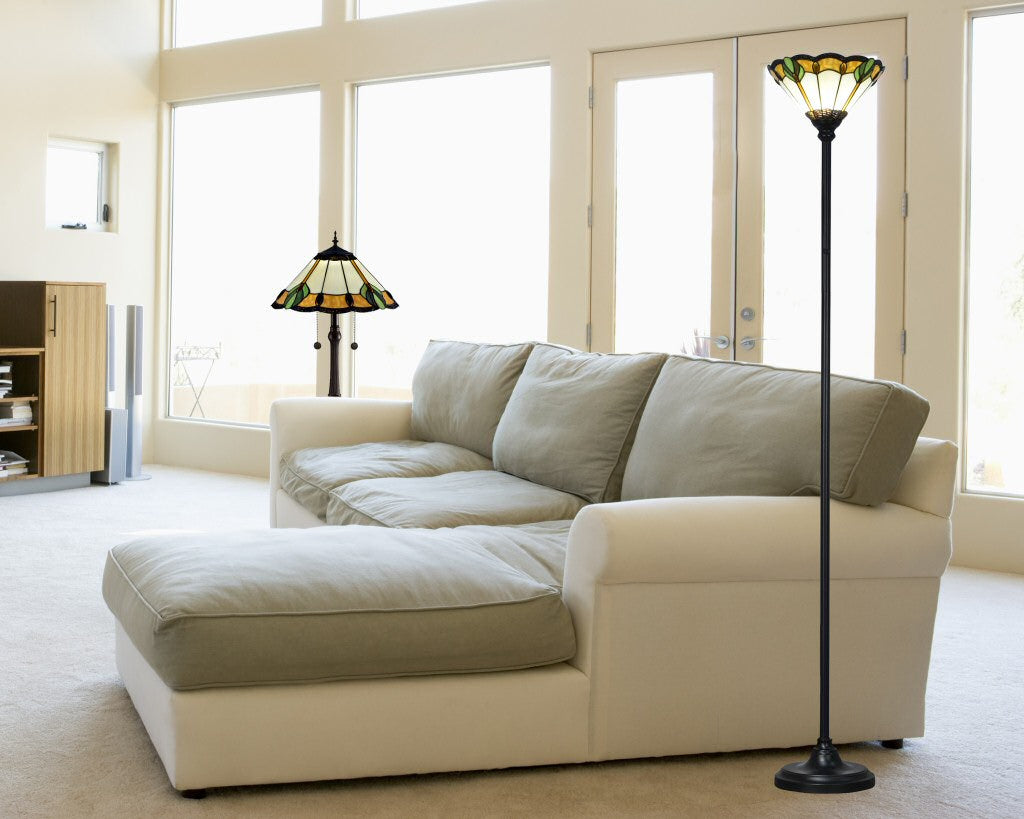
A torchiere floor lamp is similar to a regular floor lamp except it takes the form of a "torch". Light shines mostly upwards due to the upward-facing shade or reflector. This means light will bounce mainly off the ceiling producing ambient light.
A torch lamp is good as a general light to increase the light in the room, but is less appropriate to use as a task lamp, for example to read by. Since most of the light shines upwards and outwards, some torchiere lamps will include a downward-facing reading lamp on the end of an adjustable arm. This compensates for the upward light by creating a focused light aimed downwards, making it more suitable over a chair.
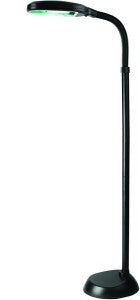
A torchiere can be placed almost anywhere in the room but due to its height may be best placed away from foot-traffic and perhaps towards the corner of the room or behind a seating area.
Floor reading lamps
A special kind of floor lamp designed specifically to improve reading, is a reading lamp. Place a floor reading lamp next to a chair or couch. The lamp head is on the end of an arm which is usually flexible or adjustable. The lamp extends over the edge of the chair and shines light down from above
It's ideal to position a reading lamp either behind or to the ides of your chair so that light will reflect away from you and not into your eyes, reducing glare. Also look for full-spectrum reading lamps which feature a bulb designed to enhance vision, reduce glare, improve contrast and create a more relaxing light in which to read.
Modern reading lamps also feature LED bulbs and a dimming feature. They also double as very versatile lamps for crafts and hobbies.
Arc lamps
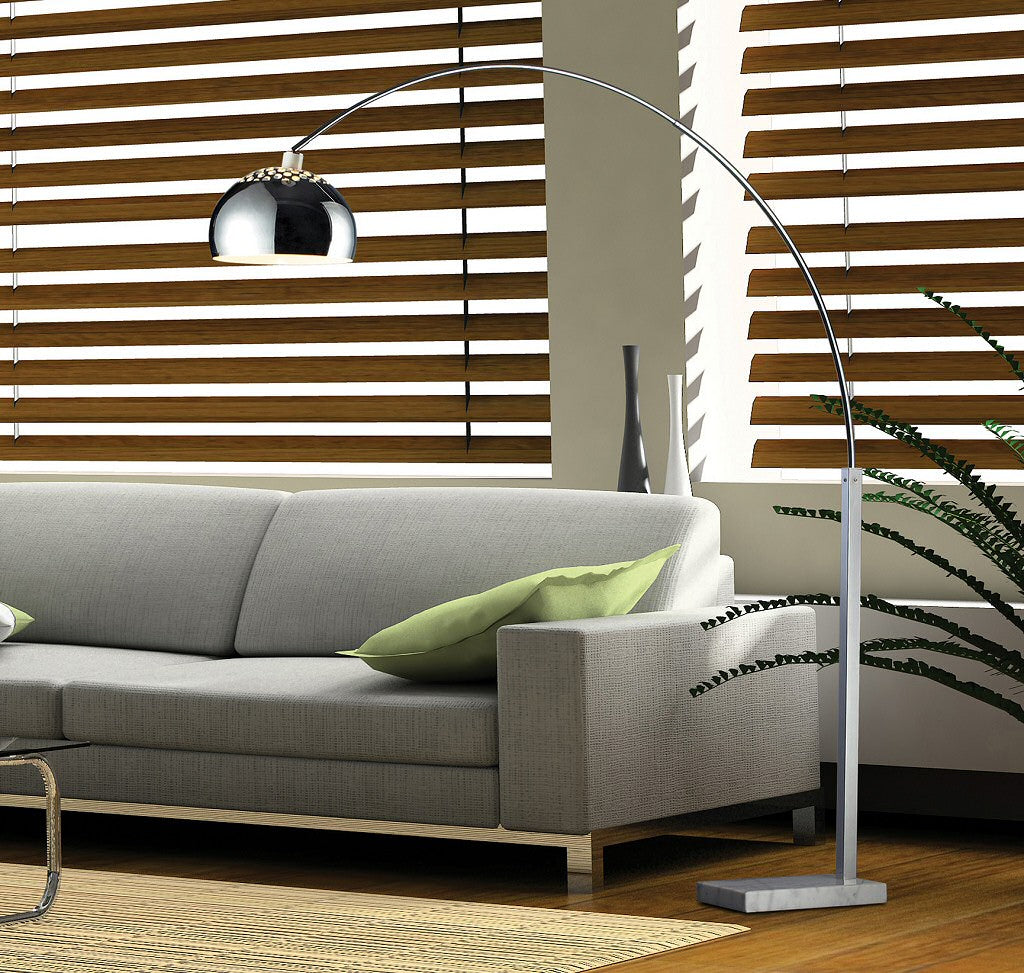
An arc lamp is a floor lamp with a long curved "arc" extending out of the pole. The pole arches over some kind of furniture or seating, and hangs a shade at the end of the arc. The light from the lamp is mostly aimed downwards, although it depends on the design of the lamp shade.
An arc lamp will make a more contemporary statement in the room and are useful over a couch or chair. An arched floor lamp is a good way to provide overhead lighting without having to install an overhead light fixture, for example to place light in the middle of a couch which would otherwise be difficult to access.
Floor lamps with shelves
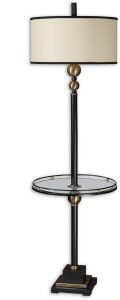
A floor lamp can double as a piece of furniture when you choose a floor lamp with a shelf. This might even extend to the lamp rising up out of a small multi-shelf unit as a floor lamp with table attached. The lamp can also optionally feature a tray which surrounds the mid-section of the pole to provide a place to store objects.
Placing a floor lamp with shelves next to a chair for example provides the benefits of a nearby floor lamp, plus the benefits of a small piece of furniture onto which you can place a TV remote, book or other item.
LED floor lamps
LED is a newer technology of providing light output without using a traditional light bulb. Light is emitted from diodes which are electronic components. Multiple LED lights are used together to produce a higher amount of light output with less wattage used, saving energy and money.
With an LED floor lamp, the bulb in the lamp will last much longer than traditional bulbs and possible long enough that you'll never have to replace it. LED bulbs can also produce light of a "full spectrum" nature - quite white, which is good for rendering colors accurately and reducing eyestrain.
Place an LED floor lamp or LED reading lamp next to a chair to benefit from the comfortable light output. LED floor lamps may also be dimmable if the lamp supports this feature.
Modern floor lamps

Popular floor lamps for the home include modern floor lamps. Modern lamps often feature finishes, designs and shapes which lend themselves to a modern-day home interior, rather than traditional.
A modern floor lamp may include a torchiere floor lamp, a reading lamp, or a typically-style floor lamp. A tall floor lamp with a shade doesn't have to look old-fashioned. A stylish drum shade and a sleek lamp base will lift any room into the future.
Contemporary floor lamps also tend to feature more recent types of bulbs such as fluorescent or LED bulbs, as well as full spectrum and dimmable bulbs, added features such as colored LED lights, programmability, night lights, etc.
Tiffany floor lamps
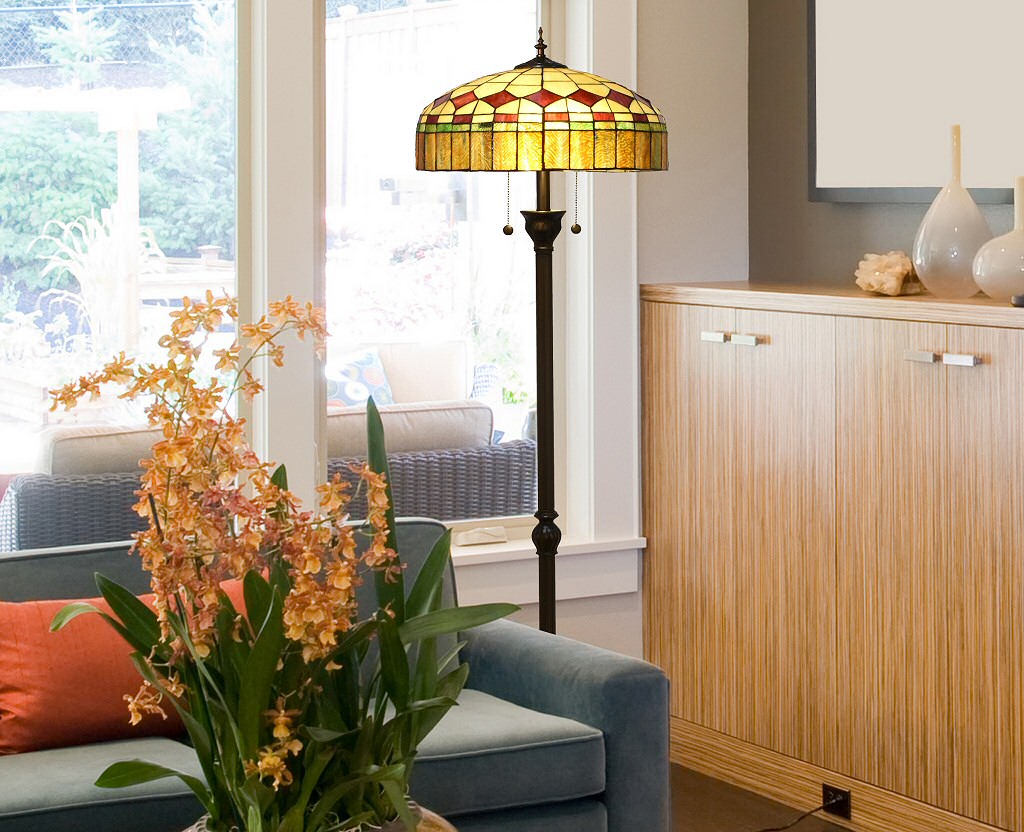
Tiffany is a style of lighting design where small pieces of stained glass are connected together to produce a design. When the light is switched on, light shines through and illuminates the glass to produce beautiful radiance and color. A tiffany floor lamp will feature a tiffany-style lamp shade.
While tiffany is quite a traditional form of craftsmanship, it is also possible to find tiffany floor lamps in a modern style, featuring geometric patterns rather than for example floral or animal-themed designs. Tiffany lamps can become a family heirloom, although they tend to be more expensive than other lamp designs.
Wooden floor lamps

Wood is a versatile material still in use for floor lamps. The base of the lamp can easily be constructed from a sculpted piece of wood of various kinds. Mahogany, walnut, oak, wooden floor lamps can tap into the natural wood themes of your room with their wooden lamp bases.
A wood floor lamp could be styled towards either modern or classic shapes. Try to match the wood tone to the other woods in your room.
Halogen floor lamps
Although becoming less popular due to the advent of fluorescent and LED light sources, floor lamps have a long tradition of featuring halogen light bulbs. The bulb tends to be very bright which is ideal for a floor lamp, although it also runs quite hot. It is also not safe to touch a halogen bulb with your fingers as the oils from your fingers will heat up and could cause the bulb to break.
With a halogen floor lamp you can be sure of a bright light. Just know that since it does run quite hot, any dust on the bulb will burn of producing a scent in the room. You can easily find floor lamps with the same brightness or better using modern led bulbs which are much longer lasting and produce little heat.
Floor lamp sizes
Floor lamps are available in different sizes. Torchiere lamps will typically reach the highest with some larger ones being several feet high. This is partly because they aim to shine most of the light toward the ceiling and so being closer to the ceiling is beneficial in making sure the reflected light remains bright.
Second-tallest is the traditional floor lamp with a lampshade. The shade will typically be at around eye-level or below when standing. These can measure up to several feet in height.
A reading lamp will always be shorter since its main function is to place light "over your shoulder" when seated, and so does not need to be as tall. A reading lamp might be no taller than 4 or 5 feet, and while being ideal for use when sitting it is less appropriate for standing.
Another kind of lamp less popular now is a pharmacy lamp. these tend to be quite short, and are helpful next to a chair or alongside a desk where the lamp head can shine downwards.
The lampshade on a floor lamp tends to be a little wider than a table lamp in order to maintain appropriate proportions to the size of the lamp base. They also tend to be closer to a drum in shape and not as flared as a table lamp shade - they position light higher up so are able to cover an adequate area below and to the sides without needing a more flared shade.
Types of table lamps

Table lamps have a long history of use in living rooms, bedrooms and various other places in homes, offices, hotels and beyond. A table lamp is designed to be placed at approximate eye level or just above, when sitting next to the lamp, so is ideally located on top of a chair-side end table or next to your couch.
The shade on a table lamp tends to be more flared at the bottom to direct more of the light to spread outwards and below. This helps them to be useful next to where you're sitting since they shed light onto your lap and the surrounding area. Placed bedside or on a nightstand they make excellent, well-established lamps.
A pair of table lamps in a living room either side of the couch or in the corners of the room can produce a nice balance and each will typically add around 100-150 watts of incandescent light, or equivalent. Modern table lamps can also be equipped with screw-in fluorescent, LED or full-spectrum light bulbs.
Since they feature a lamp shade to shield your eyes from the bulb, the lamp may also shine some light through the sides of the shade, unless the shade is lined with a hardback or similar lining.
Nightstand and bedside lamps
Table lamps function as excellent nightstand lamps or bedside lamps. When you're looking for table lamps for bedroom use, simple place a lamp either side of the bed, or just on one side if you're sleeping solo.
The lamp will provide good light for reading and relaxing, or to light the room at a moments notice if you wake in the night. You could also outfit your table lamp with a dimmer switch to soften the mood or to provide a dim light at night so as not to wake or startle people.
Bedside table lamps can serve as a reading lamp for beds although if you plan to read for a long period of time a reading lamp or full-spectrum bulb might help your vision.
Modern table lamps
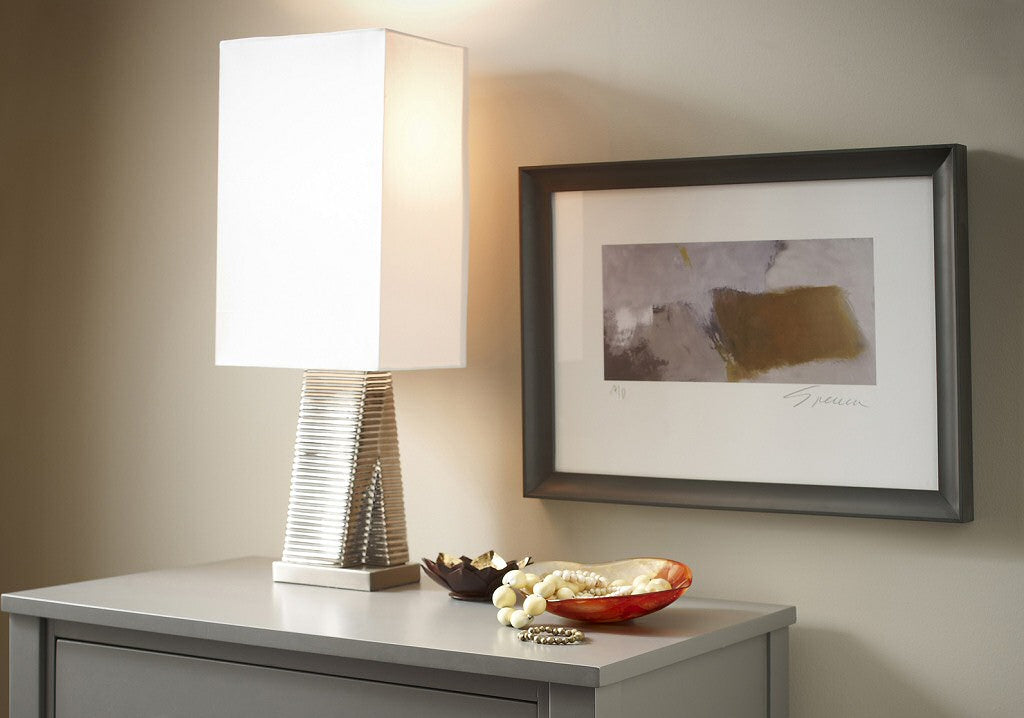
Table lamps are available in a variety of styles to suite any decor or room theme, including a modern or contemporary room. A modern table lamp will often feature clean lines, bold shapes, angular or smoothly curved profiles, and perhaps a pop of vibrant color.
A jazzy texture or pattern might also set your modern table lamp apart from the surroundings and make a bold statement. Modern also doesn't have to mean crazy, since modern table lamps can also look elegant and sophisticated, suitable for the entrance to a business or for use as hotel lamps.

Contemporary table lamps may also feature light bulbs such as fluorescent CFL bulbs or an LED light bulb. Also for a really interesting table lamp, look for the use of LED in the design or shape of the lamp itself - without being attached to a central light, modern table lamp designs are beginning to explore new ways to present and position the lights.
Crystal table lamps
A crystal table lamp will feature a portion of the lamp body which is made from cut-crystal. It is less common for the entire lamp base to be made of crystal but this does happen. Otherwise the base may feature wood or some metal material to hold the crystal portion of the lamp in place.
Crystal provides an elegant look for your lamp and sparkles and shines as you move around particularly in response to reflected light from the lamp or other light sources. Crystal table lamps tend to lean toward a more classic or traditional style so are more suited to a classy, elegant or traditional interior.
Glass table lamps
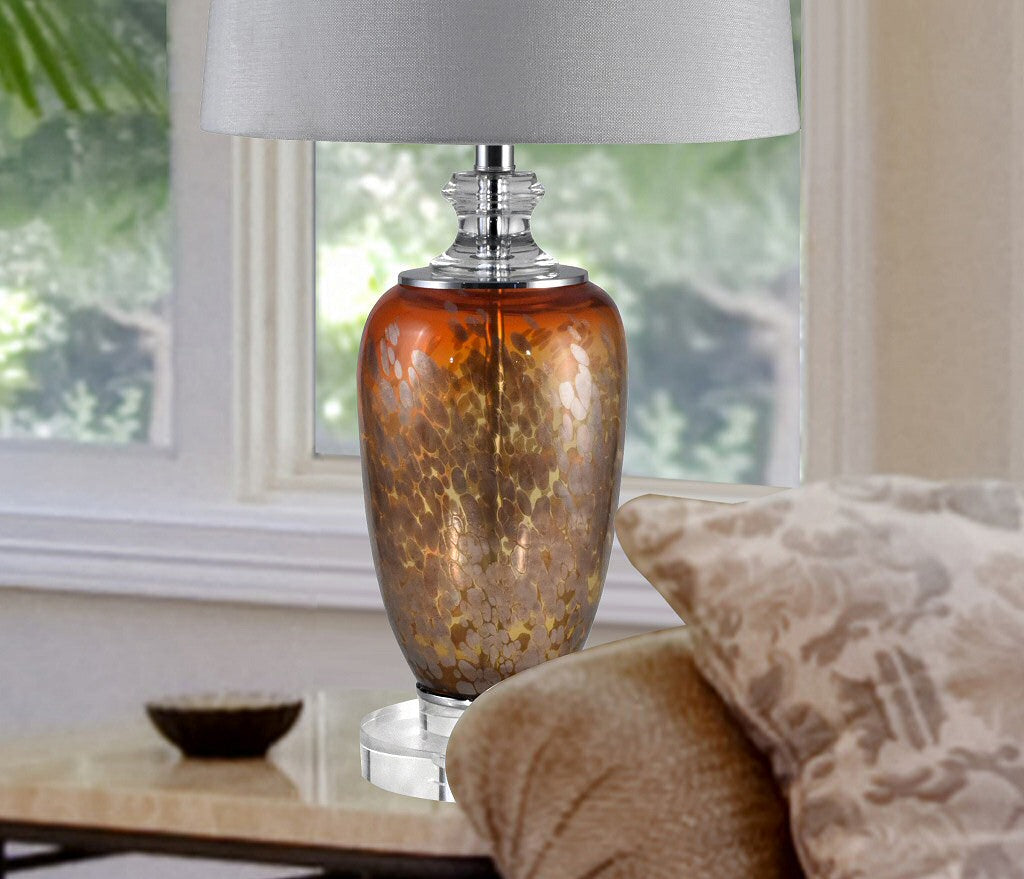
Glass or art glass is also used in some table lamps. An art glass table lamp will feature blown glass in some kind of shape which complements the lamp design. This glass lamp will feature either transparent glass or a tinted or patterned glass which may also feature deliberate distortions or bubbles in the glass for added effect.

Art glass lamps could lean toward modern or traditional styles, and often also include brightly colored glass. The glass body may also double either as a container for seashells, pebbles or other ornaments, or as a night light which glows with a low light level using its own bulb.
Since glass can be sculpted into various forms, glass table lamps may also feature a glass shade or shades, such as in the form of flowers, or as an overall shade covering the lamp.
Buffet lamps
In a narrow hallway or on a side-table, a buffet lamp sits taking up less space than a typical table lamp. Rather than simply be a smaller lamp to suite a smaller space, a buffet lamp is instead designed to be narrower with a taller, stretched-out look. The proportions are different to a regular table lamp which is shorter and wider.
So when you have that narrow hallway with barely room for a little side table or buffet table, don't think you won't be able to add a lamp - look to tall buffet lamps for a solution.
Tiffany table lamps

Inspired originally by Louis Comfort Tiffany, similar to a tiffany floor lamp, a tiffany table lamp features multiple pieces of stained glass arranged in a decorative pattern to produce a glass shade.
When the light is switched on the lamp comes to life with beautiful colored glass pieces radiating colorful light into the room. The tiffany table lamps are often designed featuring floral patterns, animals, dragonflies, roses and other popular styles.
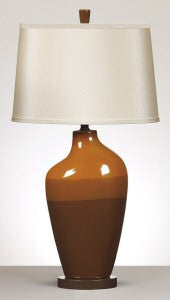
Modern tiffany table lamps have also take then tiffany concept and applied it in a contemporary theme, using geometric shapes, striking bold colors and less free-flowing designs in order to convey a sense of modern design. This also often includes embracing modern shapes of shade such as rectangular shades.
Tiffany table lamps can become long-term family heirlooms and make for a beautiful addition to any room.
Ceramic table lamps
Since table lamp bases need to be sculpted and also need to be hollow in order to allow an electrical cable to pass through, various sculpting mediums are used including ceramics, clay and other forms of pottery. A ceramic table lamp takes advantage of this by revealing beautiful ceramic designs, shapes, colors and textures.
A ceramic table lamp could be a simple spherical shape or something more sculptural, depending on your tastes. Ceramics bring in a sense of down-to-earth style and hand-made craftsmanship.
Wood table lamps

Wood is a common material used in table lamp designs and so a wooden table lamp makes for a striking addition to a room. The lamp may feature walnut, oak, mahogany or any other kind of wood. The lamp base may also feature a mix of wood and some other material such as metallic finishes.
Conveying a laid-back, relaxed appearance, a wooden table lamp base can connect with the other wood elements in your room and also complements an elegant or tradition-themed room very well, since woods have been in use for a long time in furniture design.
Table lamp sizes
Most table lamps are in a size range of around 18" up to 32" or so. At the upper range is about where you'll find buffet lamps reaching up into the 40"+ range. Small table lamps or mini lamps are also available, for example to position in a small space in a bedroom. These may be as small as 12" to 18" in height.
Not to be confused with accent lamps which don't always "look like" a table lamp, and tend to be more sculptural and artistic-looking, a small table lamp might be the ideal choice if you need less light and have less room, since they typically will also feature light bulb that isn't as bright as a full-sized table lamp.
Beware of buying smaller table lamps if you need to proper light a room or if you are expecting a full-size lamp - these small lamps are often much cheaper but it's because they're petite and you might not be happy with the size or the light output.
Oversized table lamps or large table lamps are also available in the 30" to 36" or so range, and are better suited to a larger room where the proportion of a smaller lamp might not look appropriate.
Types of desk lamp

A desk lamp typically sits on a desk or office surface. A desk lamp is designed so that the head of the lamp extends out over the desktop and shines downwards onto an area that the lamp itself does not occupy.
Whereas a table lamp's base will be directly below the light source, making it impossible use the light directly below the light bulb, a desk lamp places the light to one side so that you can make use of the area below.
Desk lamps are particularly practical with flexible arms, bendable goosenecks and pivoting heads to shine the light where you need it. They can easily be moved out of the way quickly or re-positioned to focus the light where you need it and keep it out of your eyes.

Modern desk lamps also include LED desk lamps, and may feature a full spectrum bulb as well to enhance your eyesight and reduce eyestrain when using the lamp for long hours of work. A desk lamp also works very well for crafts and hobbies.
LED desk lamps
Plug in an LED desk lamp and you won't have to worry about having ample light or that the bulb might burn out. Typically an LED-based desk lamp will last many years of continued use. Usually they last so long that they are not even designed to have to replace the bulbs, ever.
With LED now, your lamp also provides an energy savings, because LED bulbs require less watts to output the equivalent amount of light as a much more energy-draining incandescent bulb. Over their lifetime they'll save you money on replacement bulbs and energy costs compared to old-fashioned lamps.
Adjustable desk lamps
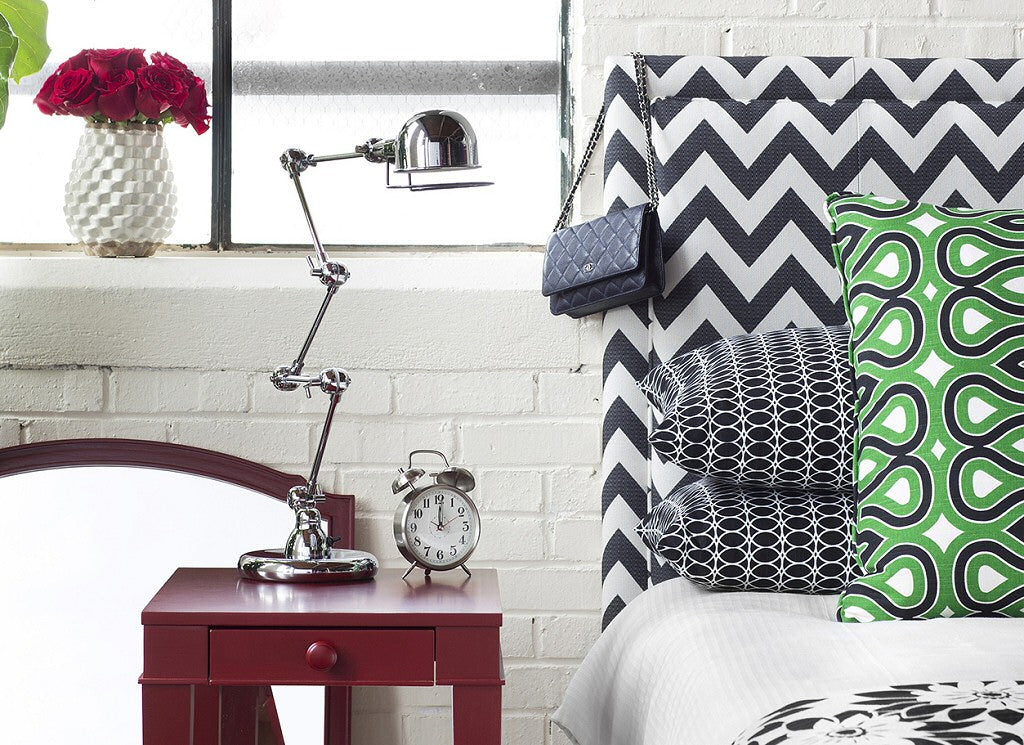
Since desk lamps are particularly useful on a desk where you are working, reading and writing papers or performing intricate tasks, they are usually designed to be quite adjustable so that they can meet your needs. Compared to a table lamp which more or less sits in one position, a desk lamp is often adjustable in several ways.
They may include a swivel adjustment at the lamp base, a flexible arm, possibly an elbow joint, and pivoting ability at the neck where it connects to the lamp head. This makes for easy adjustment. For example with a desk lamp which has spring-loaded weight bearing, it's very easy to grab the lamp and move it closer or further away and have it stay where you put it.
It could almost be said that all desk lamps are adjustable, but the amount of adjustability varies, so you should consider how you'll want to interact with it.
Gooseneck desk lamps

Some desk lamps feature what's called a "goose neck". A goose neck desk lamp has a flexible neck, usually surrounded by a flexible plastic casing, which allows the lamp head to be positioned at a wide variety of angles. This is the equivalent of being able to turn your head to look in all kinds of directions.
The benefits of a gooseneck desk lamp are that you can easily aim or tilt the lamp head so it's not shining into your eyes but is shining exactly where you need the light, and you can quickly move it out of the way if needed.
One downside is that since all the adjustability is in the neck area, the lamp may not be quite so easily re-positioned over a wider area.
Bankers lamps
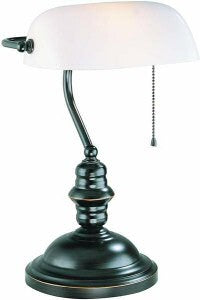
Remember the little lamps you see sitting on a crowded desk, with a small horizontal shade, sometimes in green? These little lamps are called banker's lamps since they originated for use in banks and in other office activities.
The lamp head usually can tilt up and down, but that's all. Banker's lamps take up little space and provide a modest amount of light. Being somewhat older in style, they are less flexible and usually not equipped with modern technologies. The bulbs may be more antiquated, but the lamps themselves lend a classic look to your office.
Desk lamp sizes
The range of sizes of desk lamps isn't as great as in some other types of lamps. typically they will feature a generally small "footprint" so as not to take up much desk space, enough to balance the lamp and to keep it stable. The adjustability of the desk lamp may also influence how tall or far reaching it seems to be.
Desk lamps are generally designed to focus light in an area very close to the lamp itself. While some desk lamps are smaller, you may find that they output less light. A larger desk lamp will likely house a stronger light bulb. Some small lamps offer more in terms of decorative qualities and less in terms of practical function.
One type of desk lamp which is often larger is where the lamp has an elbow joint and may be spring-suspended, allowing it to be deliberately moved around and to reach over a larger distance. These may be clamped onto the edge of a desk or may have their own base.
Due to their highly movable nature, they will inevitable be larger lamps on the whole. This includes magnifier lamps which feature a magnifying glass in the lamp head to help with reading and hobbies.
Types of lamp shades
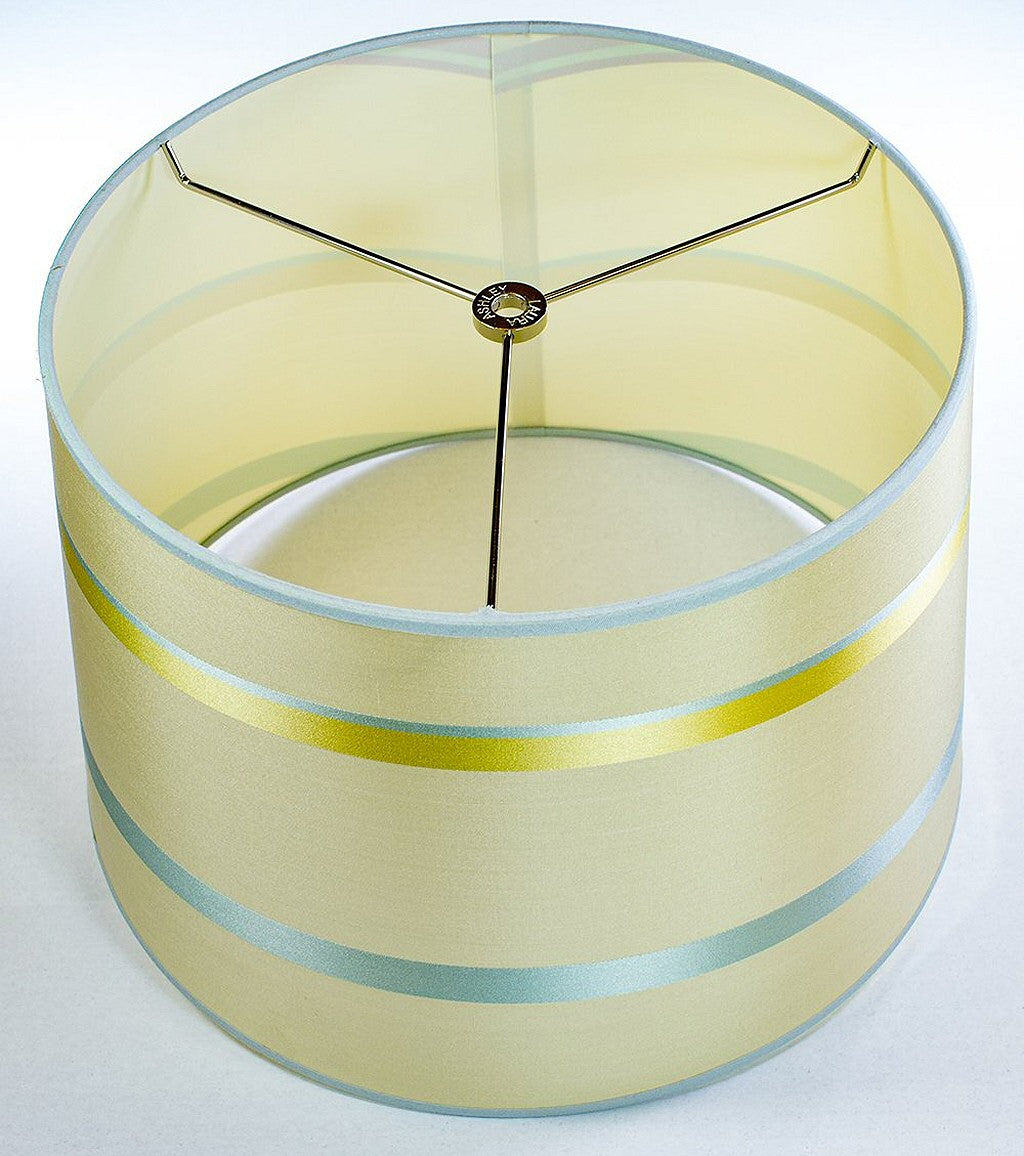
Most lamps will feature some kind of lamp shade which covers all or part of the light bulb. This helps to prevent you from staring straight at the bright light bulb which could be harsh on your eyes.
The shape, size and type of lamp shade depends on the form of the lamp, how decorative it is, and what purpose it serves. Different shapes of shade aim, reflect and direct the light so that it emits from the shade in a particular "shape" or cone.
Some lamps may feature a lampshade which emits light equally up and down, or which directs most of the light out of the bottom of the shade.
Sometimes the lampshades are also hard-backed or lined which blocks more light from passing through the shade material (which could tint and diffuse and lower the light output). More light is then reflected out of the ends of the shade, and sometimes gold-lined or silver-lined lamp shades are made for this purpose. Otherwise the light shining through the shade itself becomes decorative and combines with patterns and textures to produce interesting effects.
Usually a large lamp will need to have a large lamp shade in order to keep in proportion to the size of the base, otherwise it will look odd. A good balance has to be struck between size and overall look. Floor lamps typically feature larger shades than table lamps, and desk lamps usually have much smaller shades.
Lamp shade shapes
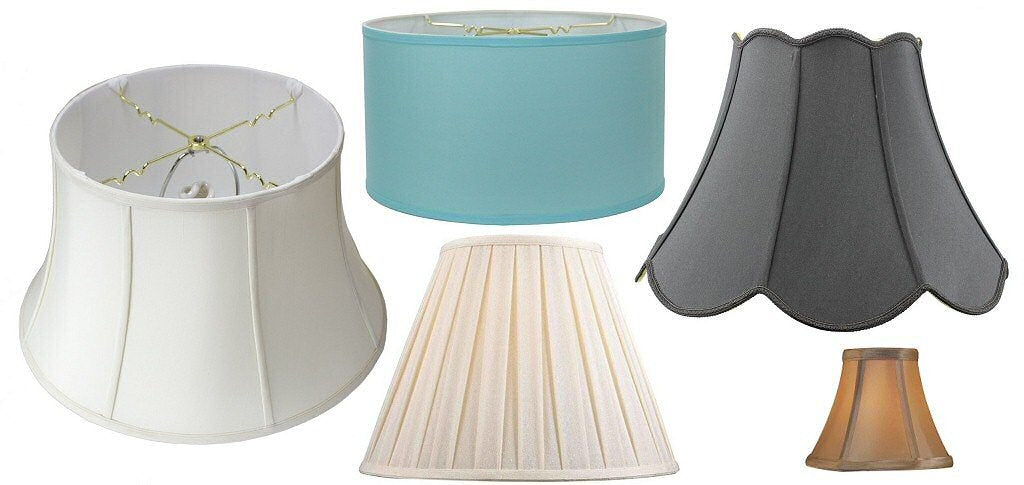 The shape of a lamp shade can be divided up onto a couple of main features.
The shape of a lamp shade can be divided up onto a couple of main features.
- The view from the side (the profile)
- The view from above or below (the plan view)
Most lamp shades are circular when viewed from above. However shades are also available with a rectangular shape, an oval shape, even a hexagonal shape when viewed from above. It's also possible that the top view of the shade is square, but perhaps the shade is a cut-cornered shaded where the corners of the square are turned inwards.
The view of the shade from the side is what you will see more often than the top or bottom view. In its basic form a lampshade is a drum or cylinder shape which from the side looks like a rectangle. Then there are varying degrees of slope introduced where the top of the shade becomes gradually smaller in proportion to the bottom. Sometimes the side-view of the shade will have curved edges, such as with a bell lamp shade, may have a rim (gallery) around the top or bottom, or additional elements.
These progress through lamp shade shapes such as drum shades (top and bottom are the same size or close to), floor shades (typically for floor lamps where the top is a little smaller than the bottom to aim light mostly downwards in a narrow funnel shape), empire shades (more often found on table lamps where the top is quite a lot smaller than the bottom and more light needs to spread out to the sides), coolie shades (where the top is especially small producing a much sharper slope).
The extreme of a shade would be where there is no top opening, and the bottom is highly flared, such as on a pendant light fixture. Some lamp shades may be especially designed with an uncommon shape such as a sphere or other artistic design.
Lamp shades for table lamps
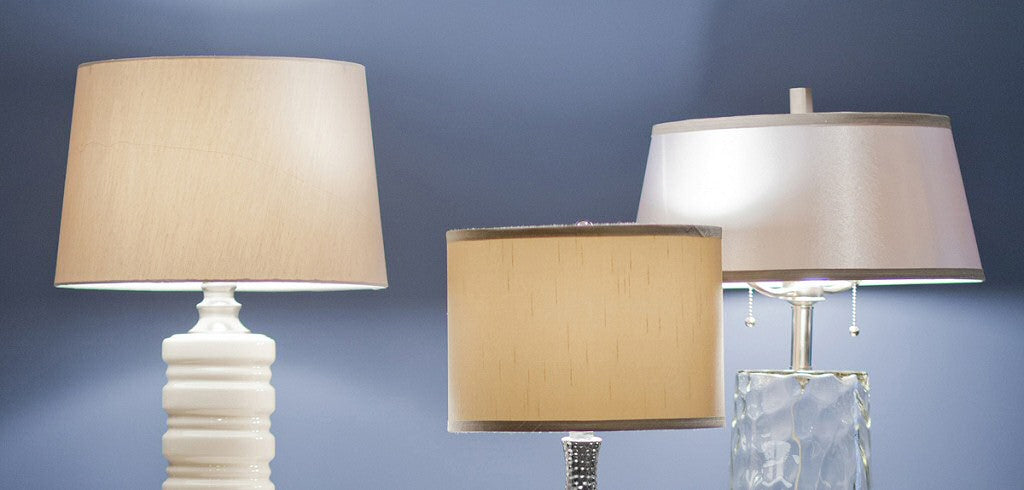
A lamp shade for a table lamp is usually flared out more at the bottom so that more light will spread outwards to the sides. A table lamp is usually placed near to a seating area and so light from below and to the sides is useful to sit nearby.
Table lamps that perhaps serve this purpose less may feature a rectangular or square shade or a drum shade which direct light upwards as well as downwards. Table lamp shades tend to be anywhere from several inches across upwards of 20" or more in large sizes. Most regular-sized table lamps are in the 14-18" range when measured across.
The height of the shade is somewhat important because it must be tall enough to cover the bulb area, and be in proportion to the lamp base size. Usually a harp fitter will rise up around the bulb and join at the top which is what the shade fitter sits on. Enough "drop" from the top of the shade down to where the shade sits on the fitter is important to position the shade at the right height. Different sized harp fitters are available to adjust the positioning.
Lamp shades for floor lamps

Lamp shades on floor lamps tend to be generally larger because the lamp base is so large. To maintain appropriate proportions the larger floor lamp shade is usually wider and often has less of a slope to the sides. The flatter sides tend to complement the tall height better than with an empire or coolie-style shade.
A floor lamp can also look elegant with a large drum shade. Since the floor lamp positions the light fairly high in the room, it will shine ample light downwards and somewhat to the sides regardless of the shade shape.
Chandelier shades

A small lampshade is used on some light fixtures and miniature lamps, called a chandelier shade. A chandelier light fixture may feature several bulbs on the ends of arms which extend out from the center, and the shades cover individual bulbs. These mini lamp shades are designed to mount near the bulb of to clip onto the bulb itself. These shades are generally too small for use on lamps.
Glass lamp shades
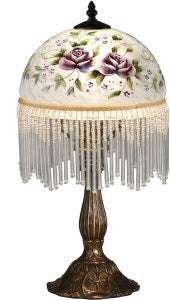
Sometimes a lamp shade isn't made of typical materials like fabric, paper, plastic etc. Sometimes a lamp design call for a glass shade. The shade might be formed form a single piece of toughened art-glass or in the form of multiple stained-glass pieces such as on tiffany lamps.
Glass shades tend to be a little more expensive and difficult to replace if they receive damage. But they can look very attractive and glow with beautiful colors in a way that other types of shades cannot match.
How to measure a lamp shade
Lamp shades are usually measured in 3 dimensions. All measurements are in inches:
- The width across the top
- The width across the bottom
- The height of the shade, measured on a slant. If the shade has a sloped side or a curved side, the tape measure or ruler should measure from the rim of the top of the shade to the rim of the bottom of the shade.
An additional measurement is sometimes given if the shade, when viewed from above or below, is not circular or square. A rectangular or oval shade will need an extra measurement for the depth from front to back, and if the shade has a larger bottom than top, it will be an extra measure from the top front to the top rear, and from the bottom front to the bottom rear.
If you don't know what size shade your lamp base needs, for a table lamp you can measure the height from the bottom of the base to just below the socket. The lamp shade should generally be around this width to be in proportion. For a floor lamp, estimating a size is harder without a shade to reference but you can try a shade in the range of 16" to 20" bottom width.
See our lamp shade buyer's guide for more information.
Lamp shade fitters
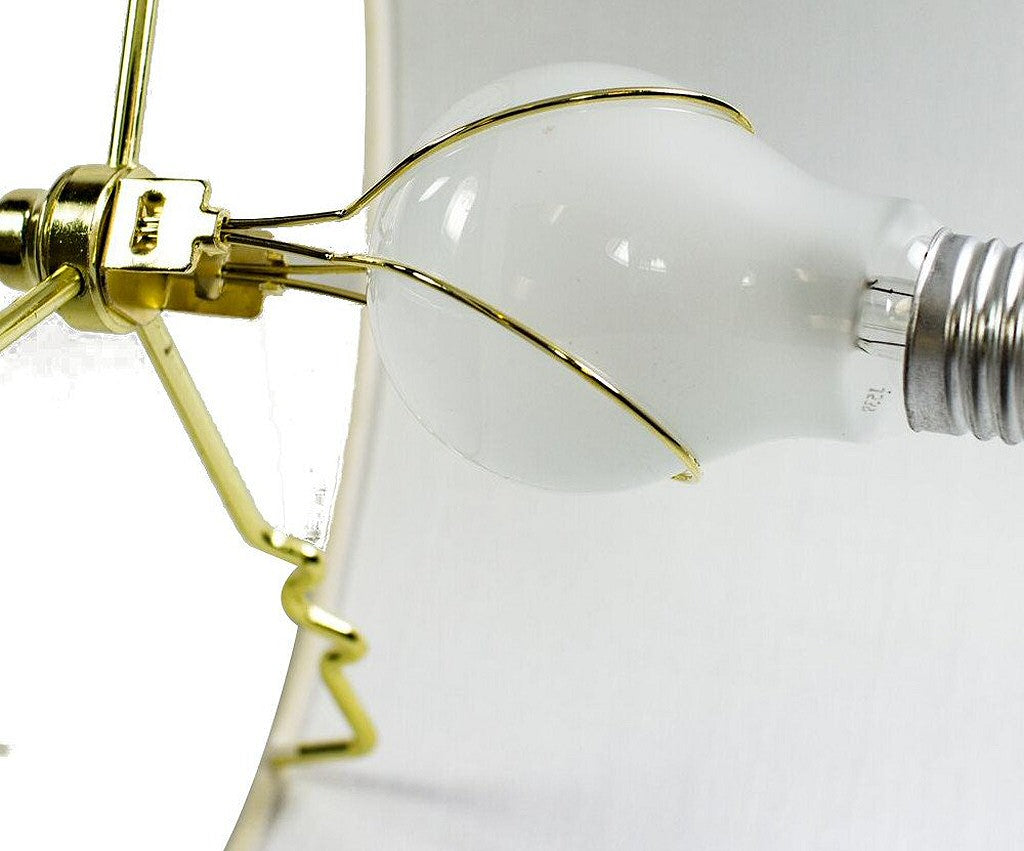
A lamp shade attaches to a lamp using some kind of "fitter". Usually the lamp shade itself has something built into the shade's frame which extends out of the top rim of the shade and inwards to the center where it connects to the lamp in some way.
Harp spider fitters
When the arms join in a central ring, this is usually called a spider fitter. This sits on top of a lamp harp. A lamp harp is a wire frame which sits below the socket where you plug in the light bulb, and rises up around the bulb and rejoins at the top. It will feature a screw thread on top, which goes up through the spider fitter and is secured by a decorative finial.
Usually there will be a slight "drop" in distance between the top of the lamp shade and the central ring where the spider fitter meets in the middle, so that this will be less visible at eye-level. Sometimes other shades, especially tall cylinder shades, may have a more significant drop in distance between the top of the shade and the center of the fitter.

If a shade cannot be positioned at the appropriate height (so as to hide the lamp socket and bulb etc), a different sized harp fitter is available, or optionally a shade riser which increases the height of the threaded pole.
UNO fitters
An UNO fitter works differently to a spider fitter. The lamp shade will feature arms which extend out from the top rim of the shade frame, in towards the center, but also with an extreme drop in height down toward the middle of the lamp. Usually the fitter from the shade then sits below the is attached to the lamp socket in some way. In this setup there is no harp fitter needed.
Sometimes an UNO fitter will feature a screw-in fitter with a threaded ring which can be screwed onto the lamp. It's also possible the lamp will feature a downward-facing light bulb also known as a down-bridge lamp. In this case the UNO fitter is designed to place the lamp shade in its correct orientation while also connecting below (which is now above) the light bulb.
Uno-fitter shades are generally much less popular than spider-fitter shades.
Tiffany Lamps

Tiffany lamps feature stained glass pieces arranged in a decorative pattern. A single tiffany lamp may feature hundreds of pieces of glass. Each glass piece is colored so that when the lamp is switched on, light shines through and illuminates the glass. This radiates colored light as well as making the lamp sparkle with beauty.
Tiffany style shades are available mainly in table lamps but also in some floor lamps. While this is a very traditional form of lamp, modern tiffany lamps are also available in contemporary styles with geometric rather than floral or animal-themed designs.
Sometimes also the base of the lamp may be constructed from tiffany glass, or part of or all of the body of the lamp may be tiffany glass, as is the case with tiffany accent lamps. These miniature lamps are highly artistic and decorative and make an excellent gift as well.
Tiffany floor lamps
A tiffany floor lamp features a stained glass lamp shade with decorative glass pieces in an attractive design. The style of the design may range from traditional to modern, and may be available in a wide variety of colors. Some classic tiffany floor lamp designs include dragonflies, flowers and other animals, while more modern tiffany floor lamps may feature geometric patterns and more angular designs.
Tiffany table lamps
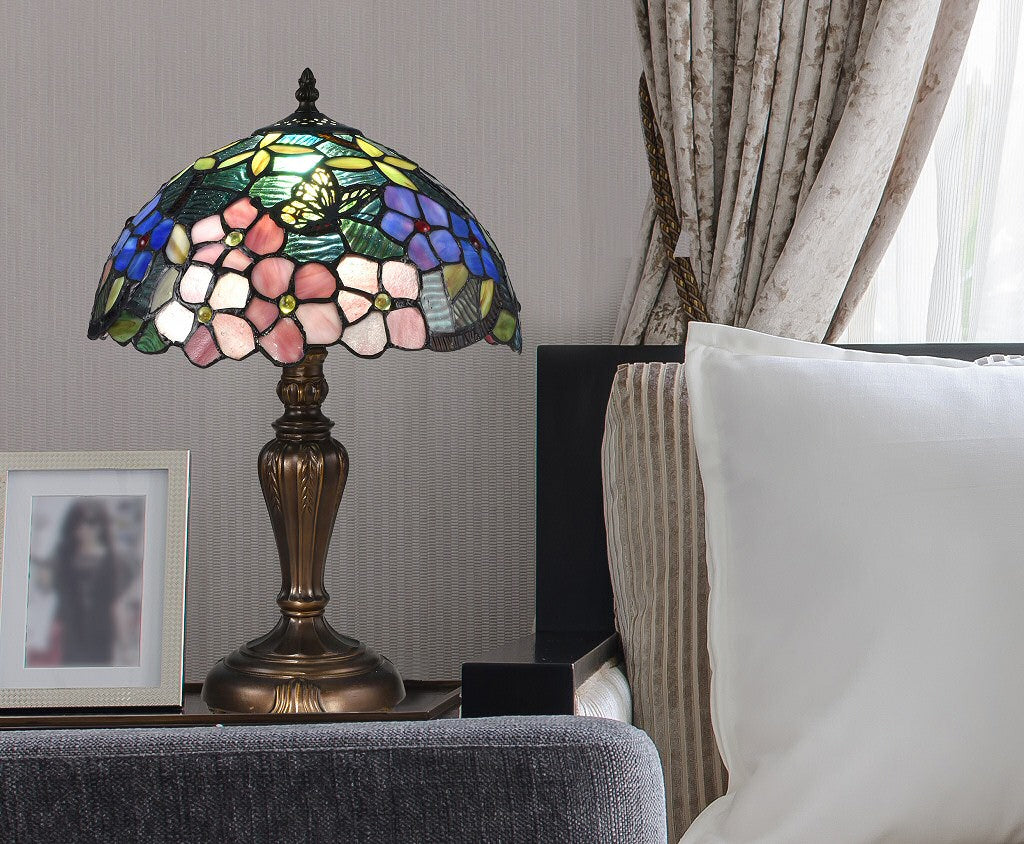
Tiffany table lamps are potential family heirlooms. Their beautiful decorative stained glass shades set them apart from other types of table lamps. They instantly become a work of art and a talking point for visitors. A worthwhile investment, long-lasting and always bringing beautiful colored light to your room.
Tiffany table lamps are also available in many traditional styles and designs as well as a modern twist on geometric patterns and bold colors.
Tiffany accent lamps

With miniature accent lamps you'll often find small lamps with tiffany glass shades, or even possibly an entire lamp which is just tiffany glass with a light inside. These often are in the shape of cute animals and other creatures, and can serve as a beautiful night light in any room. The decorative stained glass shade radiates colored light when the lamp is on.
Lamp Sets
It's worth checking if a set of lamps are available. Sometimes a complementary design spans two or three types of lamps such as a floor lamp, table lamps and an accept lamp. Also it's quite popular to purchase a pair of table lamps and position them either side of a couch or in corners of a room to create balance. Lamps are sometimes sold in a set of 2 which allows you to quickly and easily coordinate while also making a savings.
Crystal Lamps
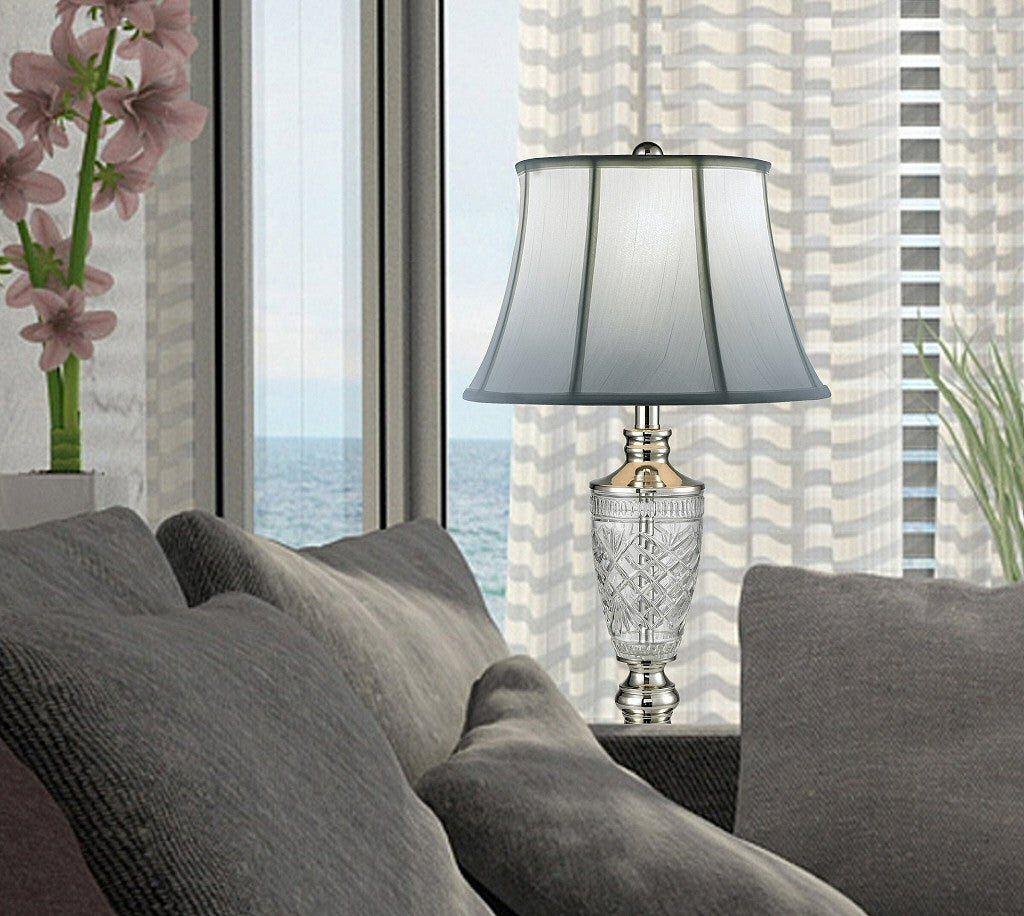
Cut crystal is an elegant material sometimes found in crystal table lamps and less often in floor lamps. The base may feature a metal or wood base at the bottom but then a beautiful, chiseled crystal body in the mid-section. The cut glass shimmers and shines as you move around the lamp, refracting and reflecting light and images from around the room and a sparkle of light from the bulb above.
Crystal floor lamps
A crystal floor lamp will sometimes feature a crystal feature near the top of the lamp pole below the shade. This adds a touch of sparkle, glamour and elegance to the otherwise featureless pole lamp. Since crystal can be somewhat expensive and isn't strong enough to hold up the lamp alone, it usually is a decorative accent on a floor lamp.
Crystal table lamps
Crystal table lamps feature crystal which can sometimes be used for the entire table lamp base or part of the base. Cleanly cut crystal pieces sparkle with the light of the crystal table lamp and shine with reflections from around the room. As you move around them, they gleam and glint, offering up a magical touch every time you pass by.
Art-glass lamps
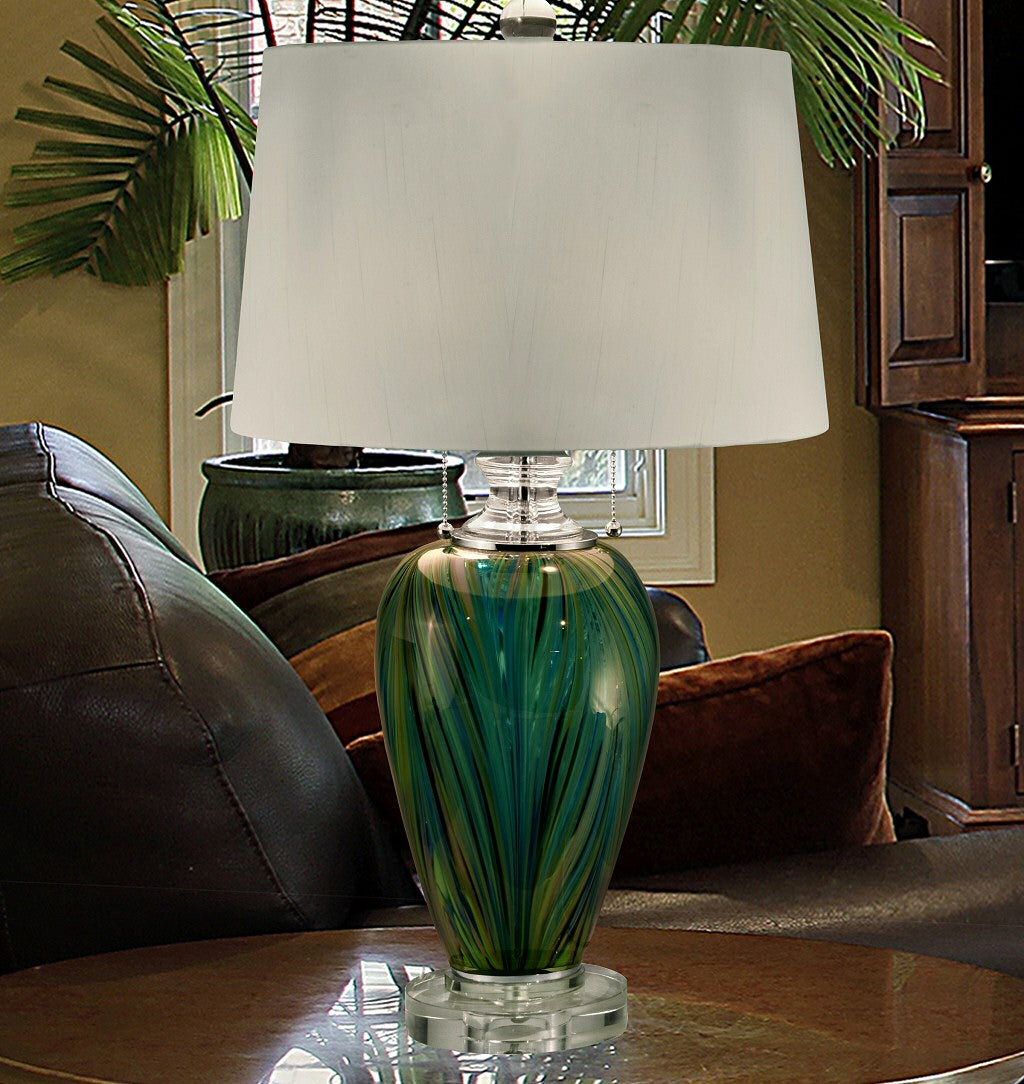
A variation on crystal lamps and tiffany lamps is the art-glass table lamp. Art glass is similar to the toughened glass sometimes used in tiffany lamps, but here the glass is usually sculpted into a single unified piece. We describe it is "art" glass because the shapes produced are entirely artistic, beautiful sculptures which perhaps produce the shape of flowers or other flowing forms. Art glass is highly colored, sometimes textured, sometimes partly transparent, and can create beautiful art glass table lamps suitable for any room.
LED Lamps

Modern technology in lighting includes the use of new forms of light emission, and in particular the shift away from energy-inefficient incandescent light bulbs and towards energy-saving or energy-efficient forms of light. We first shifted towards fluorescent lights which save money and last longer than regular bulbs. But then quickly also came the new wave of LED lighting.
LED bulbs use small electrical components called diodes to emit light. Usually a number of these are used in combination, and this offers some interesting capabilities in the design of lamps. An LED lamp may feature a single bulb which a cluster of led lights embedded into it, or it may break the mold and shift toward arranging the LED lights along the structure of the lamp itself, opening creative new design possibilities.
LED lamps last longer than regular lamp, use much less energy than other types of bulbs, can often be dimmable, and are becoming increasingly more affordable.
LED floor lamps
LED floor lamps are the cutting edge of floor lamp design. Featuring small LED bulbs has allowed modern floor lamps to explore new super-minimalist designs that take up less space and have a much less noticeable profile.
A particular favorite among newer floor lamps is the LED reading lamp, which features full spectrum LED bulbs designed to help you with reading and clarifying the subject on the page so that you have less eyestrain. LED floor lamps are rising in popularity and will soon take over where older technologies left off.
LED table lamps
LED in table lamps hasn't as yet been as popular as for some other types of lamps, but there is a growing trend toward using LED bulbs in table lamps. Often this means simply unplugging or not using a regular bulb, and instead using a screw-in LED bulb. The bulb is designed to fit a standard table lamp socket so can even be used on older lamps.
Since LED can save you time and money and energy, it can be a good choice to refit your table lamps or buy new lamps and install LED bulbs with them. You may find that you have to buy the LED bulbs separately, at least for now.
LED desk lamps

Desk lamps are further ahead of the curve in terms of supporting LED technologies. LED desk lamps have been embracing a technological advantage for some time and offer full spectrum and other LED solutions, designed to take up less space and make the lamp more versatile.
With a full spectrum LED desk lamp for example you can get the benefits of a good desk lamp while also reducing eyestrain and it provides you with long-lasting bulbs that you likely will never have to replace. LED light can be quite bright so you'll get good light output for your office work.
LED light bulbs
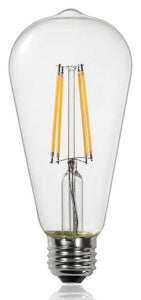
In general, LED has infiltrated the light bulb market and is rapidly taking the place of incandescent bulbs. They also are now nudging out fluorescent bulbs which, for a number years, become the next best thing after regular light bulbs.
LED bulbs are available in a typical screw-in format which can be used in pretty much any lamp or light fixture provide the size, socket and wattage are compatible. These bulbs typically feature multiple small led lights arranged on the head of the bulb.
Since LED bulbs are very long-lasting compared to others, and don't generally burn out or break like old bulbs used to, more and more light fixtures and lamps are now exploring new ways to integrate the bulbs into the design of the item itself. Perhaps a line of bulbs will wrap around a curved arm, or be arranged in a vertical pillar. Since they are very small and you generally will use several together, the arrangement of the LED bulbs is providing creative new forms of lighting and lamps.
Full Spectrum Lamps
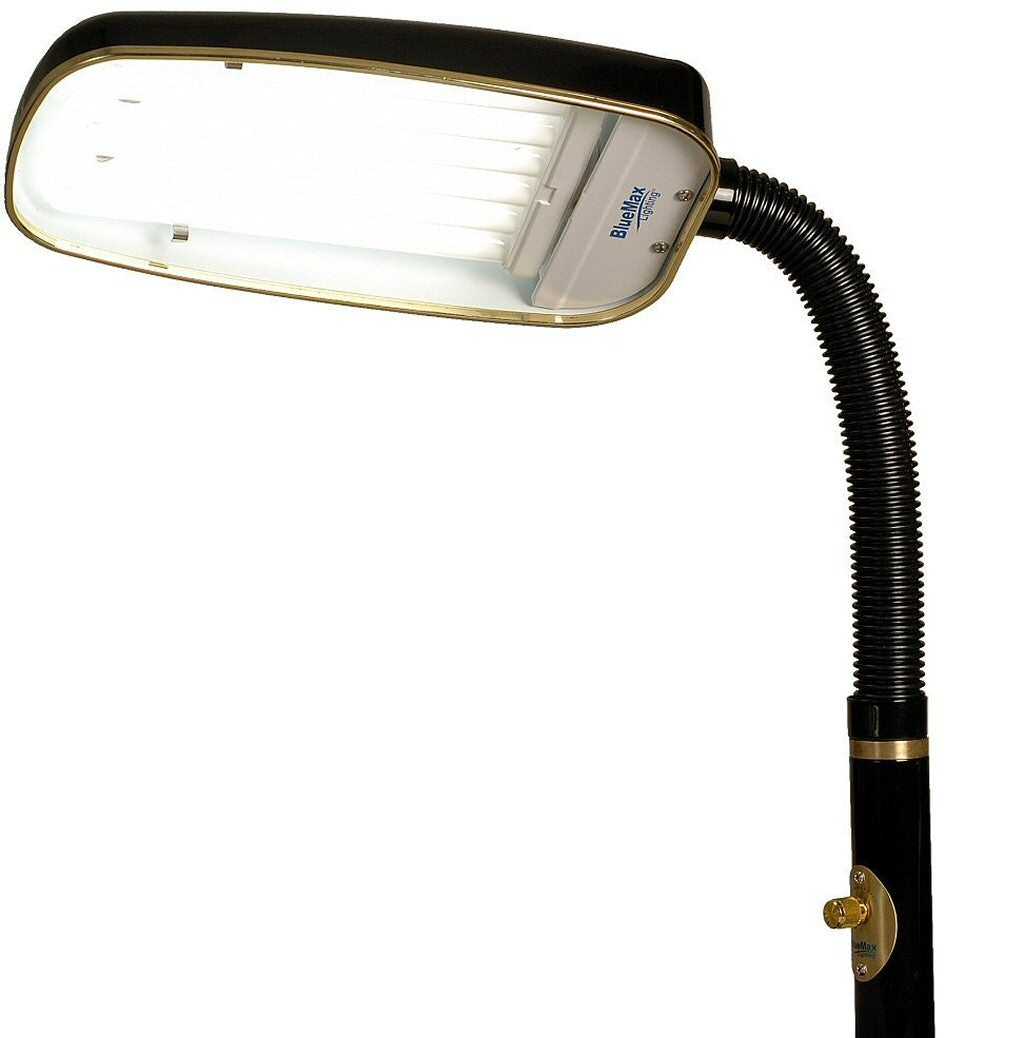
A full spectrum lamp features a light source designed to simulate natural sunlight, producing an overall "white"-seeming light which has a good balance of each color in the spectrum. These tend to be in the 6000k to 7000k Kelvin range, which is a measure of the "color temperature" of the light output, trending towards "white".
The benefit of a full spectrum light is that colors in a room will be represented closer to their natural color, you won't have an ugly yellow hue like you get form incandescent bulbs, and so the contrast and visual comfort of reading and other tasks is improved. Words on a page pop with added clarity and eyestrain is reduced.
Full spectrum lamps also have the benefit of helping your circadian rhythm which governs your sense of what time of day it is, and has an influence on how tired you feel or whether you are experiencing Seasonal Affective Disorder. An "SAD lamp" can help to reduce some of the symptoms of a lack of sunlight especially in the darker winter months.
Full-spectrum floor lamps
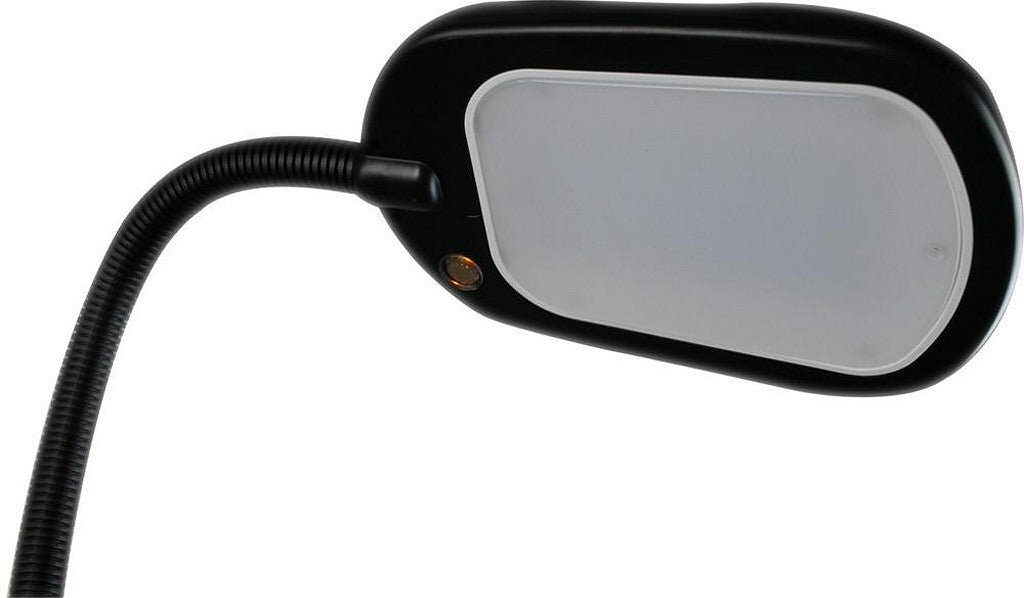
With the advent of LED lighting, floor lamps are adopting support for full-spectrum light as well. This is particularly true of full spectrum reading lamps which are designed specifically to help with reading and eyesight.
Place a full spectrum floor lamp near to a seating area or behind a couch and enjoy bright yet balanced light in your activities such as reading, crafts, hobbies and detailed work. A full spectrum floor lamp is also an excellent choice in an office where the glare of other types of light might prove uncomfortable when spending a long time working.
Full-spectrum desk lamps

Desk lamps are well suited to office work or placed on a desk where you'll be performing intricate work. The full-spectrum light provides a balanced light for reading and writing and helps to give a clear contrast to words on a page, as well as showing colors in a light closer to their natural coloring.
The even white light produced by a full spectrum desk lamp renders colors how they are supposed to look and helps you to make important business decisions as well as providing comfort for your eyes. Full spectrum light is less harsh on your eyes than other types of light.
Full-spectrum bulbs
Full spectrum light began to be available with the advent of fluorescent light bulbs which allowed a purer, whiter light to be output. This has carried over into many LED bulbs as well.
Typically "white" bulbs are marketed as natural or daylight bulbs, and may or may not be closer to the natural spectrum of sunlight. Whiter light in general will help to create more comfortable and natural light in your home or office, but particularly look for bulbs which back up their claim to mimic sunlight.
SAD lamps/sunlight lamps
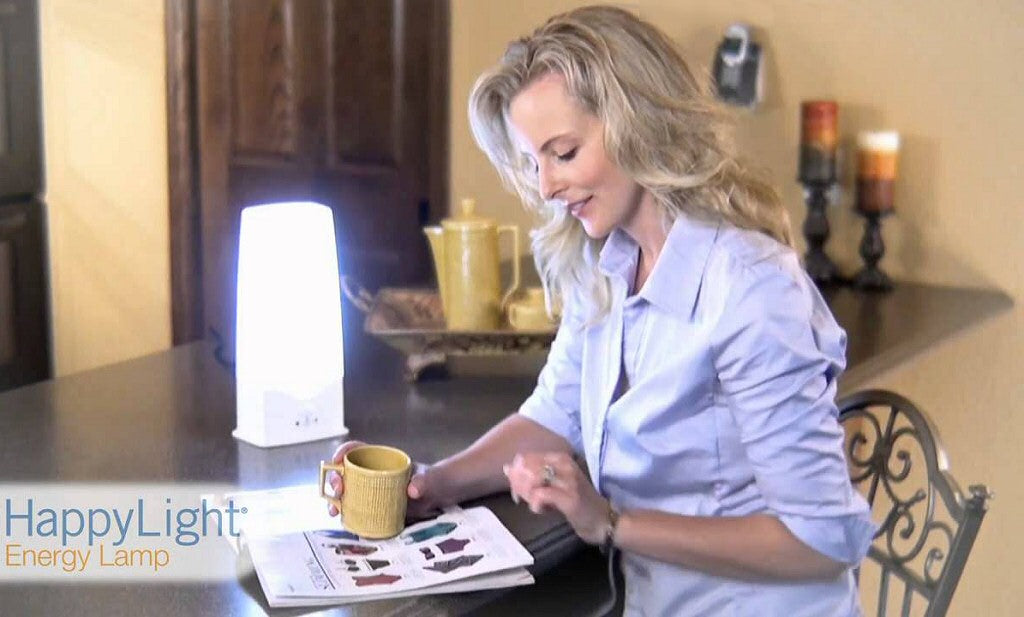
A popular use of full-spectrum lamps is to help with Seasonal Affective Disorder or "SAD". This relates to the effect of shorter days in winter on your body's circadian rhythms. This can leave you feeling lethargic or under the weather. The benefits of full-spectrum light for helping SAD and improving mood are many.
Some specialized therapy lamps have taken this a step further by providing a light box or enclosure which features a full-spectrum light. This can be placed on a desk near to where you work and shine full-spectrum light into your eyes for a period of time.
Accent Lamps
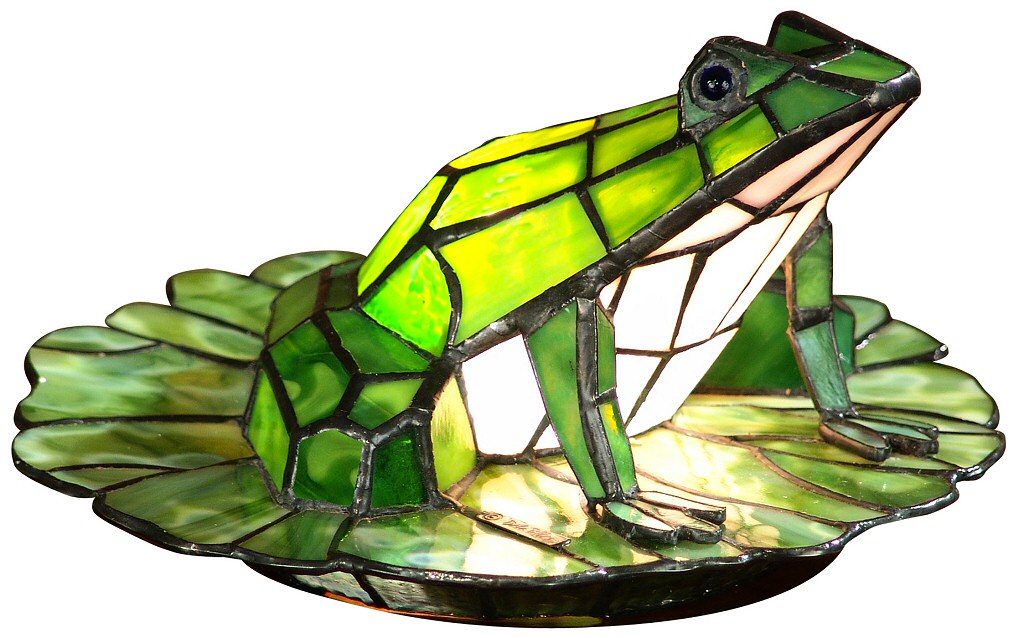
Place accent lamps at the sides of a room for an extra decorative touch. Accent lights generally don't output a bright light, but can be used as finishing touches or just for fun.
An accent lamp may take the shape of a small table lamp, or may mimic the form of various other objects or animals. For example a tiffany accent lamp might come in the shape of a butterfly, a frog or a turtle. When the lamp is switched on, the body of the design illuminates from within and lights up in various beautiful colors.
Accent lamps can be placed near to a seating area or on a coffee table in order to add charm and intimacy. They also double as a useful night light or a simple light in a child's bedroom.
Decorative accent lamps
Since accent lamps tend to be small, they generally don't output enough light to fully illuminate a room. They can be used in concert with other lamps or light fixtures, or as a low-level of lighting.
For this reason, accent lamps tend to be more decorative and feature cute or characterful designs, or artistic elements which make them more ornamental. Accent lamps can feature on a small side table, a mantelpiece, in the corner of a room or anywhere you need a little touch of magic.
Tiffany accent lamps
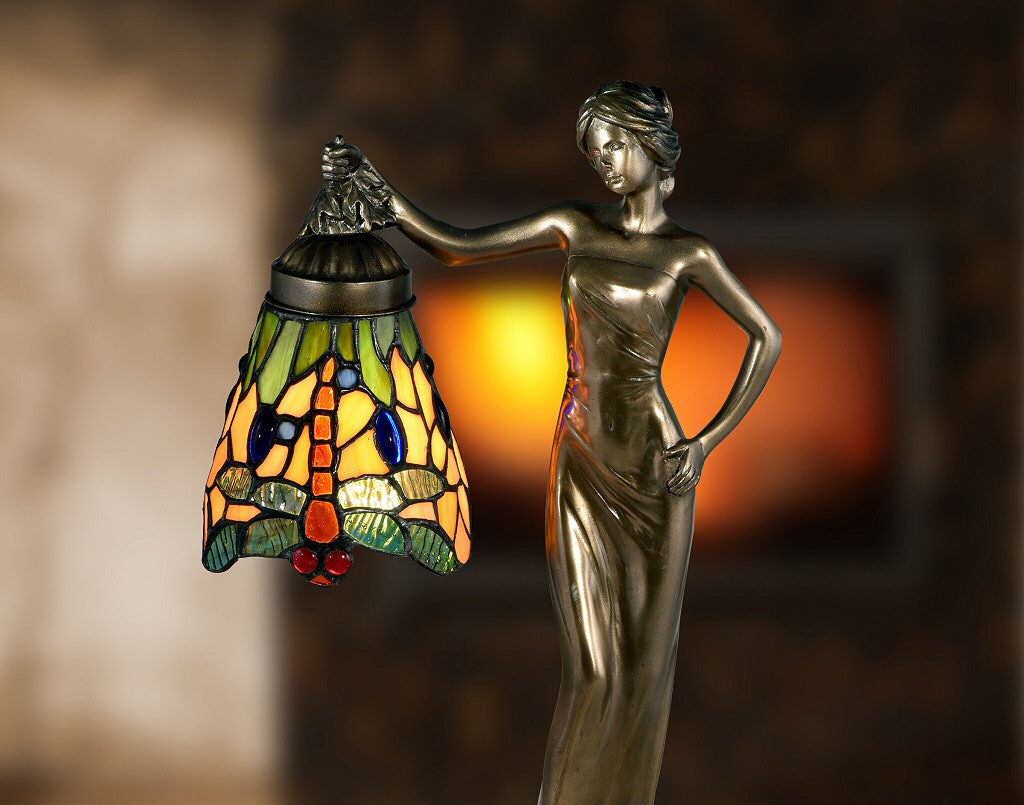
Particularly popular in miniature lamps are tiffany accent lamps which feature small pieces of colored glass. When the lamp is switched on, the glass illuminates and glows with beautiful colors.
Tiffany accents are often shaped to resemble the bodies of various animals and creatures, such as frogs, snails, butterflies, turtles, roosters and more. Usually powered by a small bulb such as a 7-watt candelabra bulb, a tiffany accent lamp makes a great night light or as a fun touch in any room.
Night lights
A night light is a small, dimly lit light which can typically plug into an electrical outlet. This small lamp may not seem very lit in daylight hours, but when the room is dark it can provide just enough light to navigate. After all, you probably don't want to be startled awake by a bright light at night.
Accent lamps can also make for a useful night light since they are often quite dimly lit and usually feature an on/off switch, whereas plug-in night lights are either always on or switch on by a light sensor.
Another option for a night light is a table lamp where the lamp has a secondary circuit providing an illuminated lamp base. A lower-wattage bulb is activated to shine within the lamp base and light it up with color, providing adequate light for use at night. The night light portion of the lamp can usually be switched on independently of the main lamp.
Task Lamps

While task lighting generally means any kind of light that you use in a specific area for performing a task, which could include light fixtures, there are a subset of lamps called "task lamps" which are designed for specialized tasks.
These include task lamps for hobbies and crafts, clamp-on lamps and work lights.
Clamp-on lamps
In a form similar to a desk lamp, a clamp-on lamp can be attached to a desk surface via a clamp which holds the lamp in place. Usually this type of lamp will feature some kind of adjustable arm or gooseneck to allow you to position the lamp head where you need the light.
Clamp-on lamps may also be able to clip onto other furniture.
Magnifying lamps
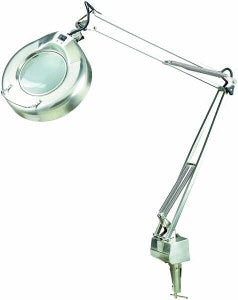
A special type of task lamp is the magnifier desk lamp which features a large magnifying glass integrated into the lamp head. Usually accompanied by integrated light bulbs or LED lights, the magnifier lamp is especially useful for people with visual impairment, or generally for use in detail work.
When you are working on small details like for a craft or hobby or reading small print, a magnifier desk lamp is excellent for increasing the size of what you're looking at, while also lighting it, so that you can sure to be accurate.
Magnifier floor lamps are also available with an adjustable arm and are useful for the elderly or those with vision problems or disabilities who need extra support for simple tasks like reading a book.
Craft and hobby lamps
Task lamps, some floor lamps and also desk lamps, can make for excellent craft or hobby lamps. The lamp head can be positioned close to where you need to see fine details. A magnifier lamp can be used to highlight small details and provide extra accuracy. A full spectrum bulb helps to enhance colors and contrast and are excellent for any kind of hobby including reading.
Specialty Lamps
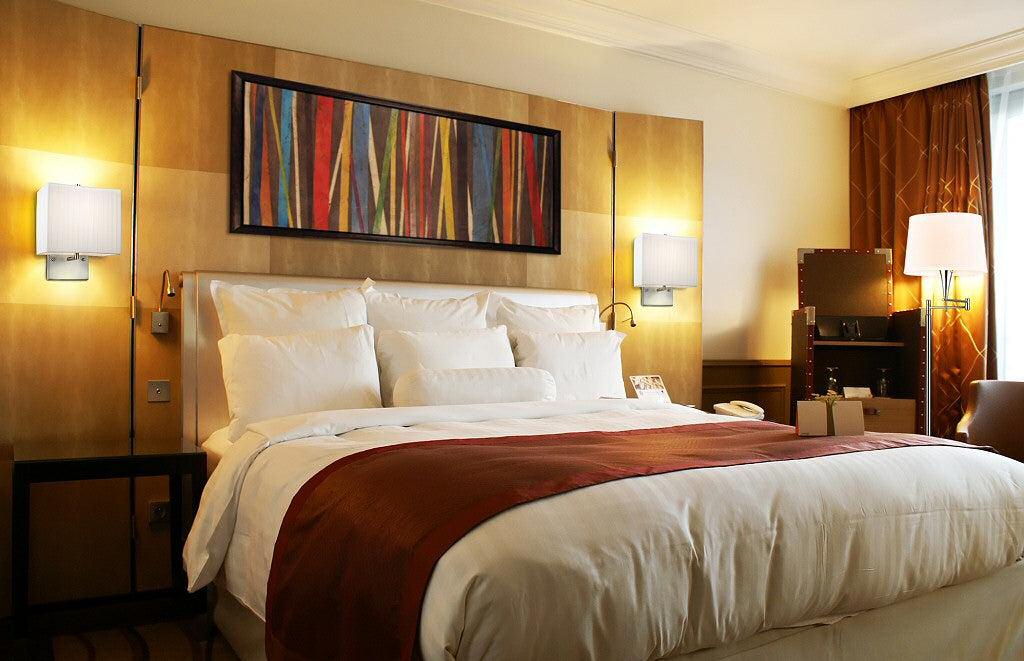
While most mainstream lamps are general purpose and useful in a variety of rooms, sometimes particular room features call for a specialty lamp. Think for example of a hotel room which has practical needs for guests, or lamps for use outdoors or in an office.
Hotel Lamps
Lamps designed for hotels have to meet certain requirements. They should look attractive and fit with the theme of the room, provide some kind of electrical outlet support, a switch, and an efficient light bulb. It may also include some kind of USB charging station for mobile devices, and possible dimmability.
Piano Lamps
A piano lamp is a small lamp similar to a bankers lamp which sits on top of an upright piano and shines light downwards so that sheet music and keyboard keys can be easily seen.
Outdoor Lamps

Placing lamps outdoors produces electrical hazards and so special types of lamps must be designed with electrical safety in mind. The lamp also has to bear the elements and so needs to be weather resistant and to some degree waterproof.
Outdoor lamps are more difficult to find than indoor lamps, but there are some available. These are designed to be especially water-safe and to resist weather and harm from sunlight exposure. The indoors goes outdoors and these lamps are especially well suited to a deck or patio, creating a sense of comfort in an outdoor living space.
Office Lamps
An efficient and comfortable working environment should include adequate lighting and flexibility of lamps so that you can work comfortably without eyestrain and for long periods. Improper office lighting can lead to headaches and fatigue.
Particularly look for a full spectrum lamp of some kind to give the office more natural light, especially if you have limited windows. Also consider a desk lamp which is a perfect fit for any office and doesn't take up much desk space. As an alternative you can try a banker's lamp.
A good reading lamp can also be a valuable addition to any office.
Lamp Styles

Lamps are available in almost any style to suite any theme of room. And within each style you're sure to find a wide range of variation and creativity. Lamps are available in all imaginable colors, textures and shapes using a wide range of materials.
Think about what the style of your room is, does it lean towards masculine or feminine? Does it seem more traditional or modern? Are you using soft muted colors or bright colors? How is the contrast? What kind of shapes are in the room? These can all be factors that help you to find some lamps which match in order to establish a room theme.
Modern lamps

A modern room is best suited to modern lamps, featuring contemporary clean lines, clearly defined shapes, smooth surfaces, metals or bright colors, and generally designed to match with a modern-themed room.
Modern lamps include modern table lamps, modern floor lamps and more. Modern lamps will tend to avoid intricate ornate details and focus more on making a striking statement, using materials, colors and finishes which weren't typically available years ago.
Traditional lamps
In contrast to the modern lamp is a traditional lamp. Table lamps and floor lamps have been in use for many years and used to be more often constructed from simple materials such as bronze, brass and wood. Traditional lamps using traditional materials will tend to fit better with a more classically or elegantly themed room.
Traditional lamps also more likely feature small intricate details, ornate ornamentation, and decorative little touches of craftsmanship which instantly speak of time-honored traditions and experienced craftsmanship.
Cool lamps
Popular with younger audiences and also in a modern home, you can find many cool lamps with striking design elements, fun themes and colorful explosions of artistry. Lamps that make you go "wow" or make a striking statement. Cool lamps are generally more often considered modern lamps, since the use of different types of materials and modern design capabilities often lends itself to cool designs.
Rustic lamps

A popular type of lamp is a rustic table lamp which brings natural elements into play, such as use of wood, bark, twigs and leaves, or designed in such a way as to resemble elements of nature. Antlers for example, pinecones, branches and other aspects of the outdoors that bring added comfort and relaxation to your room.
Industrial lamps
A modern twist is the industrial lamp which may feature stark elements of modern industry such as pipes, cogs and gears, tubing or wrought iron, and other hints of industrial design.
Vintage lamps
Vintage-styled lamps may in fact be genuinely vintage or simple made in a vintage-like style. Featuring classical elements and proven designs, vintage table lamps for example create a throwback to times gone by and are reminiscent of original lamp designs.
Antique lamps
Older lamps can become antiques and are quite collectible. An antique lamp will likely have to be purchased from some third party owner who has had the lamp for some time, since antique lamps are generally not bought as "new".
Lamp Parts

Lamps are typically constructed from a few key parts although modern lamps may deviate from this more.
Lamp bases

All lamps typically have a lamp base on which the lamp sits. The base is designed to be heavy enough to stabilize the lamp and make sure it won't topple over. The base can tend to be heavy, especially in the case of a floor lamp which uses a weighted base to help the lamp stay upright and stable.
The base will also then possibly feature other design elements, particularly in the case of table lamps and accent lamps, whereby there is room between the surface and the lamp shade for decoration. The lamp base may feature room for inserting your own ornaments such as pebbles or seashells, may be solid of transparent or a tinted color, or may be constructed of a solid material such as ceramic or glass.
The base extends upwards and provides support for the neck of the lamp and its socket.
Lamp Sockets
The lamp base supports the lamp socket and helps to position the light source higher than the surface on which it sits. This is especially true for floor lamps which can place light high in the room and need to use a tall pole to do so.
The socket will usually be positioned on top of the neck and will accept a light bulb with a compatible base. This might be a screw-in socket or a twist such as with a GU24 base used for some fluorescent bulbs.
The socket will also often be the location of a lamp switch.
Lamp Shades

In order to shield your eyes form a bright light bulb, a lamp typically uses a lampshade or some kind of diffuser. The lampshade surrounds the bulb and reflects most of the light in a specific and useful direction.
The lamp shade is often attached to the lamp via some kind of fitter or bracketing which connects it with the body of the lamp. Lamp shades also serve the purpose of funneling heat from the bulb upward out of the top of the lamp, similar to a chimney.
Lamp Harps and Fitters
In order to attach a lamp shade to the lamp, it needs a way to hold the shade in position, attach it to the lamp body, and rise it out of the way of the light bulb (which produces heat).
Usually the framework of the lamp shade itself will include arms which draw to a central position, which can then be used to attach to the lamp. The shade will either screw or attach onto the lamp socket in some way via an UNO fitter, or will sit on top of an additional lamp harp via a spider fitter.
A lamp harp is a wire bracket which rises up around the bulb and connects at the top, providing a platform on which the spider-fitter of the lamp shade can rest, secured by a decorative lamp finial.
Lamp Finials
A lamp finial is a small decorative accent for a lamp which screws on top of the lamp and holds a lampshade in place. A simple small finial can be used or you can take the opportunity to decorate with a beautiful designer finial which come in various shapes and designs ranging from crystals to animals to wood carvings. You can accentuate the design of the lamp and also touch upon themes from your room by choosing a custom finial for your lamps.
Lamp switches
Lamps will always feature some kind of on/off switch. In some cases, a lamp may support a 3-Way bulb which means that you can operate the switch in 3 positions for Off, Low and High settings. This requires a special type of 3-Way light bulb which supports this functionality, or the use of multiple bulbs e.g. in a floor lamp.
Various types of switches may be used ranging from slide and rocket switches, through pull-chain switches and onto in-line cord switches. The switch may also offer dimming capabilities, but you'll need to check that the light bulb supports dimmability.
Dimmer Switches

Typically you can add a dimmer switch extension to most lamps provided the bulb and lamp support it. This is a simple extension cord which includes an in-line slide switch. This is allows the voltage to be adjusted to the lamp, making the light bulb brighter or dimmer.
Note that to use a dimmer switch the bulb has to support this functionality. It will work effortless with incandescent bulbs but a fluorescent bulb may need a certain minimum level of power in order to light at all. Similarly an LED bulb may need a special kind of dimmer because LED bulbs are electronic devices often using a different power adapter.
Finally, Lamp Do's and Don'ts
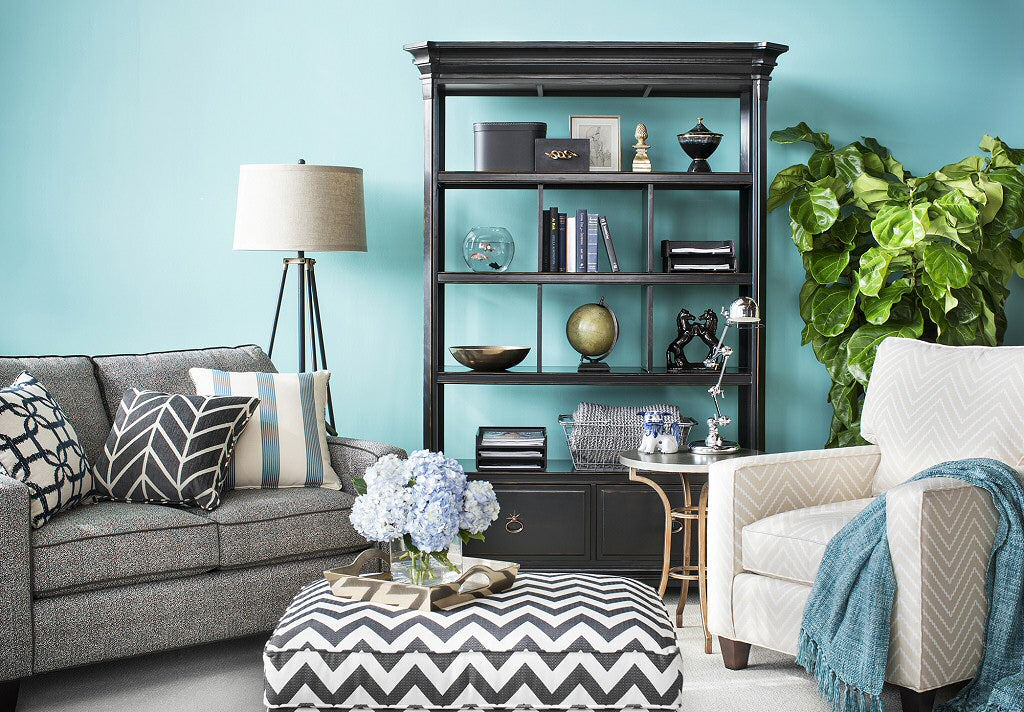
Always refer to the electrical safety instructions of your lamp in order to use it safely as intended. Important things to keep in mind include the following:
- Do not use a light bulb with a higher wattage than the lamp socket is rated for. There is usually a rating number on the socket itself.
- If your lamp has a 3-Way socket you can still use a regular on/off light bulb with it, it just won't provide dimming.
- If your lamp is dimmable, make sure the light bulb you use with it is designed to be dimmable. Generally speaking incandescent bulbs can be easily dimmed but fluorescent and LED may or may not support it.
- Do not cover your lamp with a fabric cloth for decorative purposes. A lamp shade is designed to funnel heat from the light bulb out of the lamp so if you cover the opening it will trap heat and produce a fire hazard. Remember the lampshade functions like a chimney.
-
Do not allow the light bulb to touch or be very close to other materials as it will generate heat and could be dangerous.

- You can put lamps onto extension cords, but always beware of overloading them.
- Do not place lamps in or near to any kind of water or liquid, or within reach of being toppled over into any kind of liquid.
- Be careful to keep lamps from being knocked over by adults, pets or children as this could produce harm or a fire hazard. Beware of pets or other creatures damaging the electrical cord. If the internal parts of the cord become exposed, the lamp needs to be repaired.
- Check for frayed wiring and repair cords safely and when unplugged.
- Always unplug the lamp from the electrical outlet before performing any maintenance.
- Keep the lamp free of cobwebs and dust. When the lamp is on it will produce a burning smell if the bulb is dusty.
- Keep fingers away from the exposed electrical elements in the lamp socket.
- Turn the lamp off (and/or unplug) before changing the light bulb.
- Use a lamp shade on the lamp rather than a bare lamp base in order to shield your eyes from glare and to prevent the bulb being broken.
- Install a dimmer switch to soften the light for your eyes if it seems too bright, but only if the bulb allows dimming.
- Replace faulty lamp switches as they could cause a fire or electrical harm.
- Do not use the lamp if you've seen smoke or burning coming from the lamp head or base.
Where you can find a good selection of affordable lamps
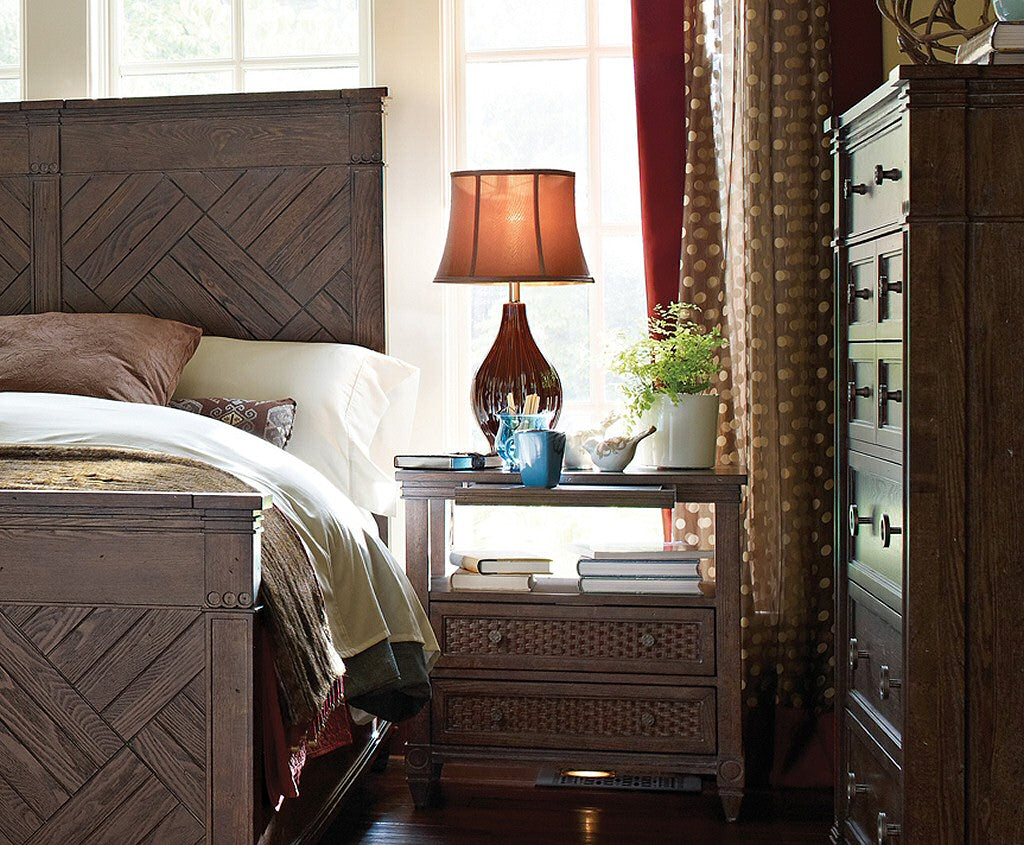
Here at LampsUSA we pride ourselves on providing a wide range of lamps with all kinds of shapes, sizes, colors, themes, styles and prices. There's something for every budget and every kind of room. We've categorized lamps by their types and sub-types and you can also filter by colors and styles.
Have a look at these popular lamp collections:
Explore Topics

Table of Contents
Lamps: How to Choose Floor Lamps, Table Lamps and Lamp ShadesLearn all about Bedroom Lamps and Living Room LampsWhat is a lamp?Bedroom lampsLiving room lampsLamps for other rooms of the homeThe shape of light outputWhere to place portable lampsHow to match the lamp style to your room themeHow much light does a lamp produceHow adjustable is the lampTypes of floor lampsFloor lamp sizesTypes of table lampsTable lamp sizesTypes of desk lampDesk lamp sizesTypes of lamp shadesHow to measure a lamp shadeLamp shade fittersTiffany LampsLamp SetsCrystal LampsLED LampsFull Spectrum LampsAccent LampsTask LampsSpecialty LampsLamp StylesLamp PartsFinally, Lamp Do's and Don'tsWhere you can find a good selection of affordable lampsCommentsShopping Ideas
Trending
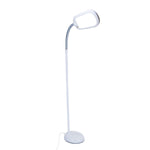
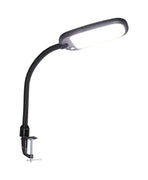



















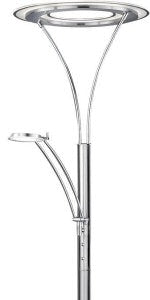
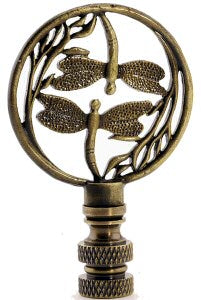




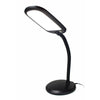







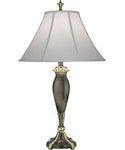
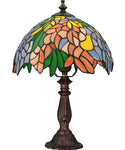
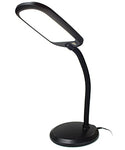
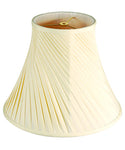


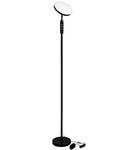
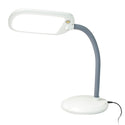
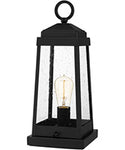
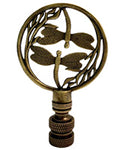
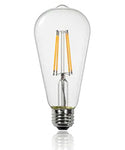
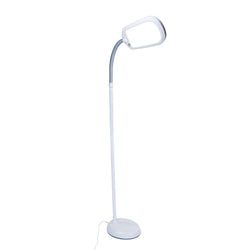
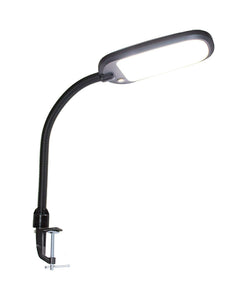
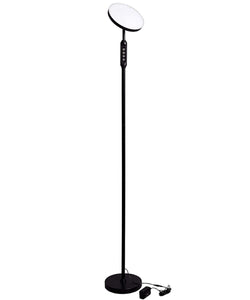

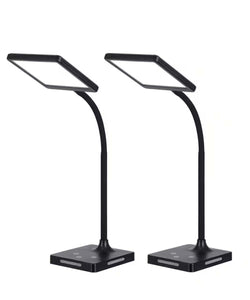
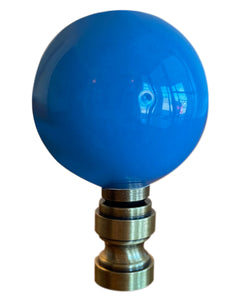

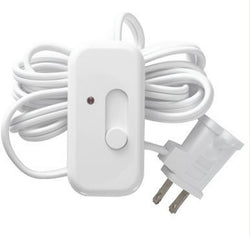
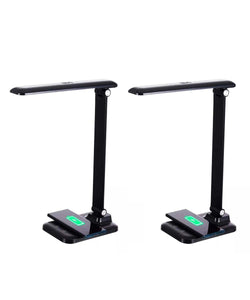
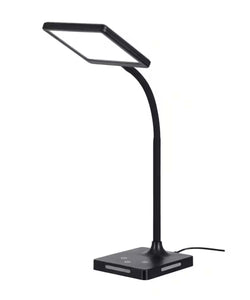



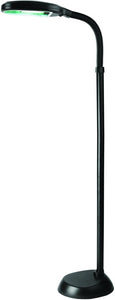

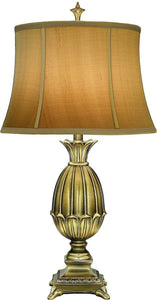


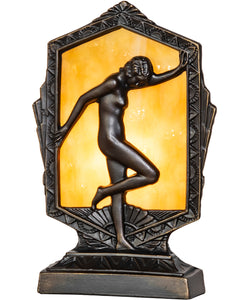

Comments